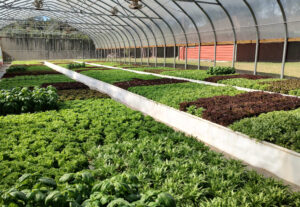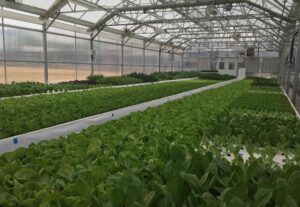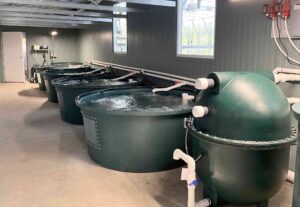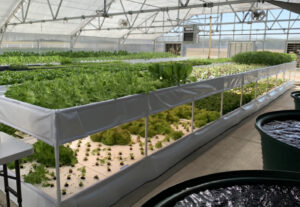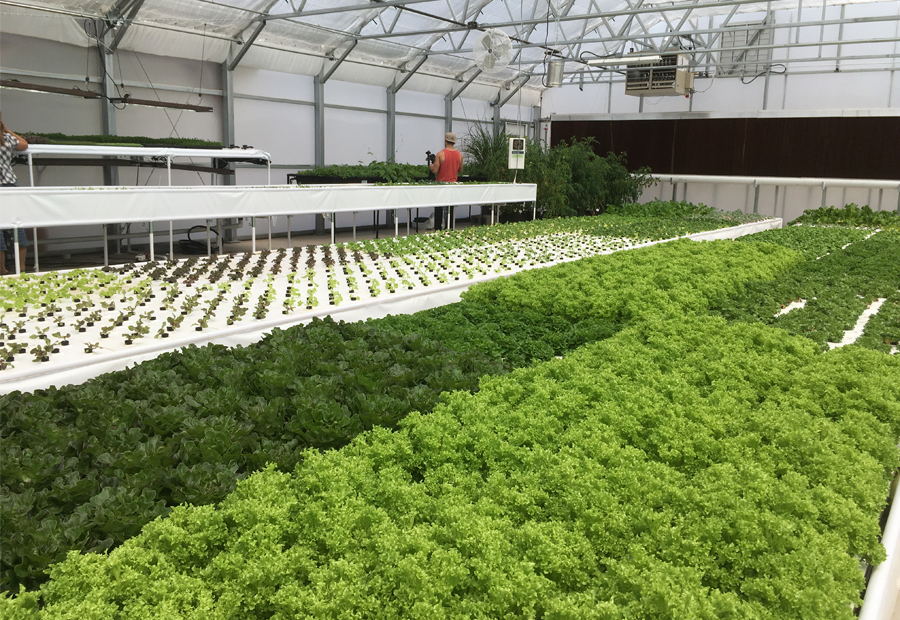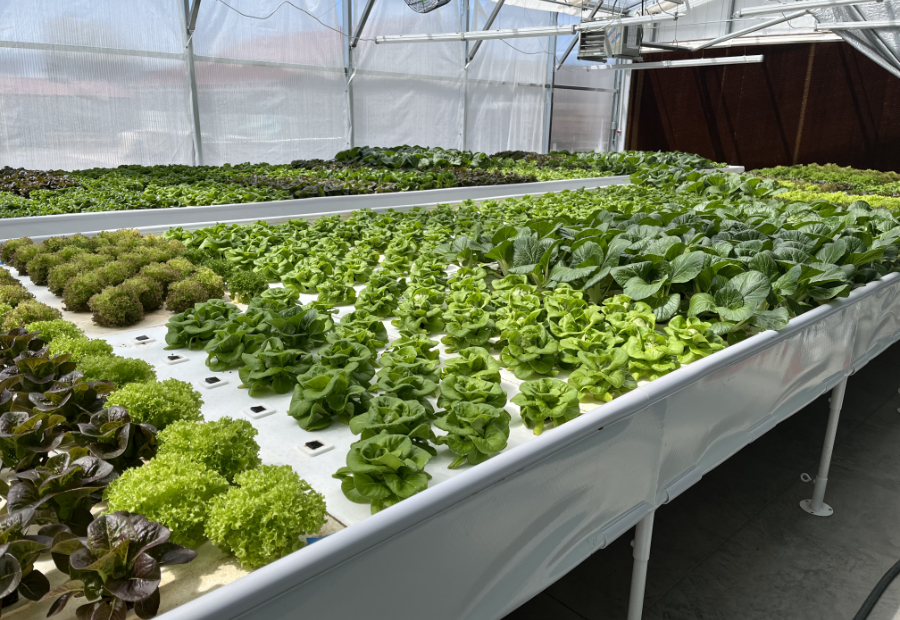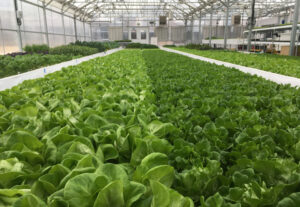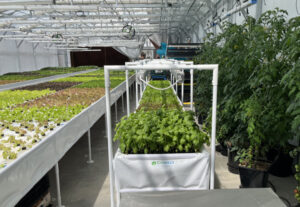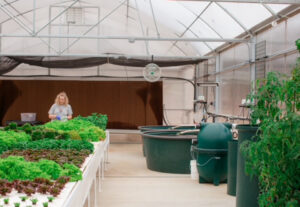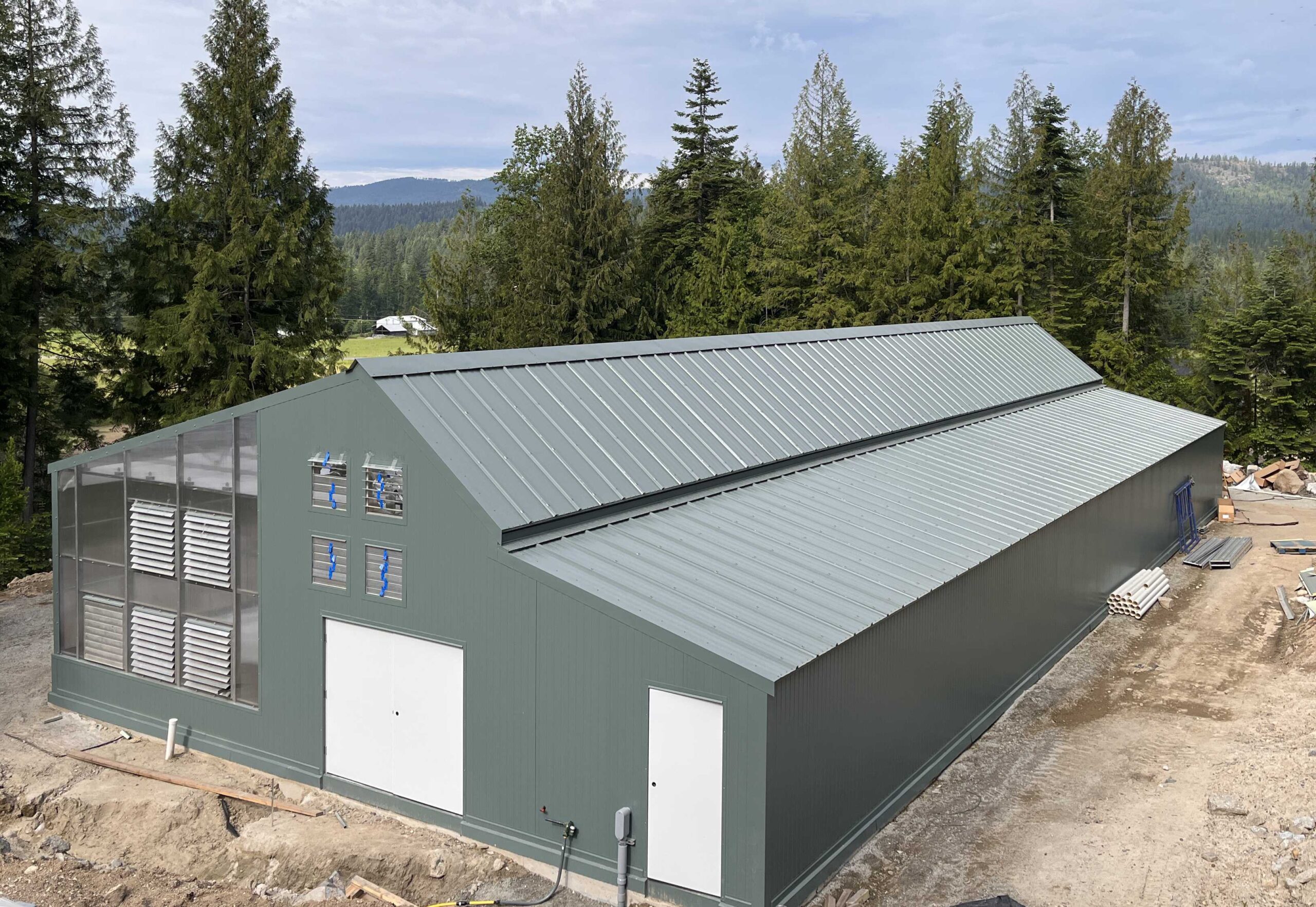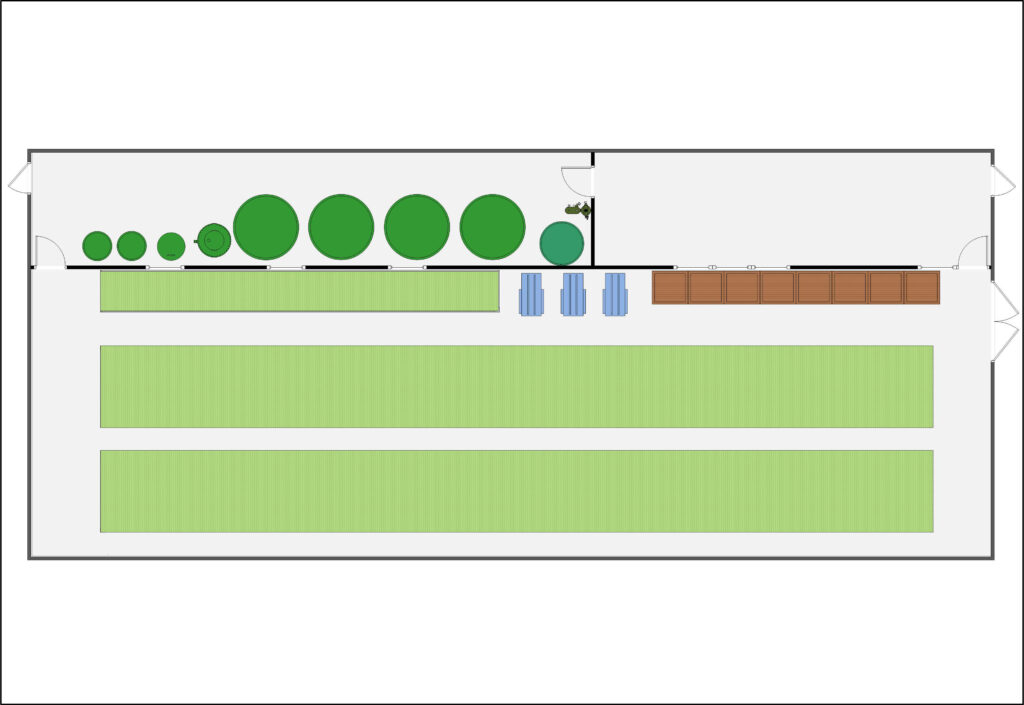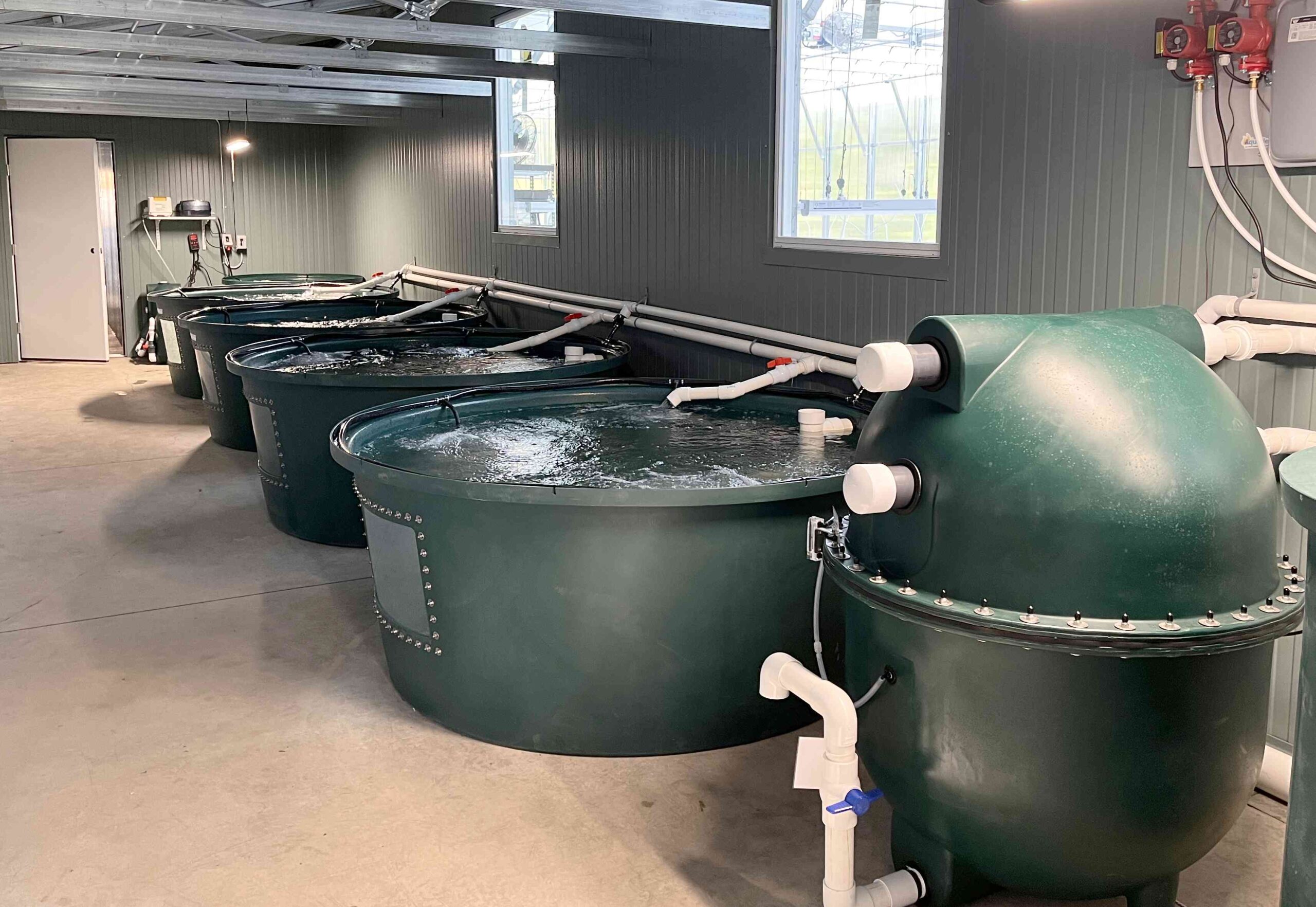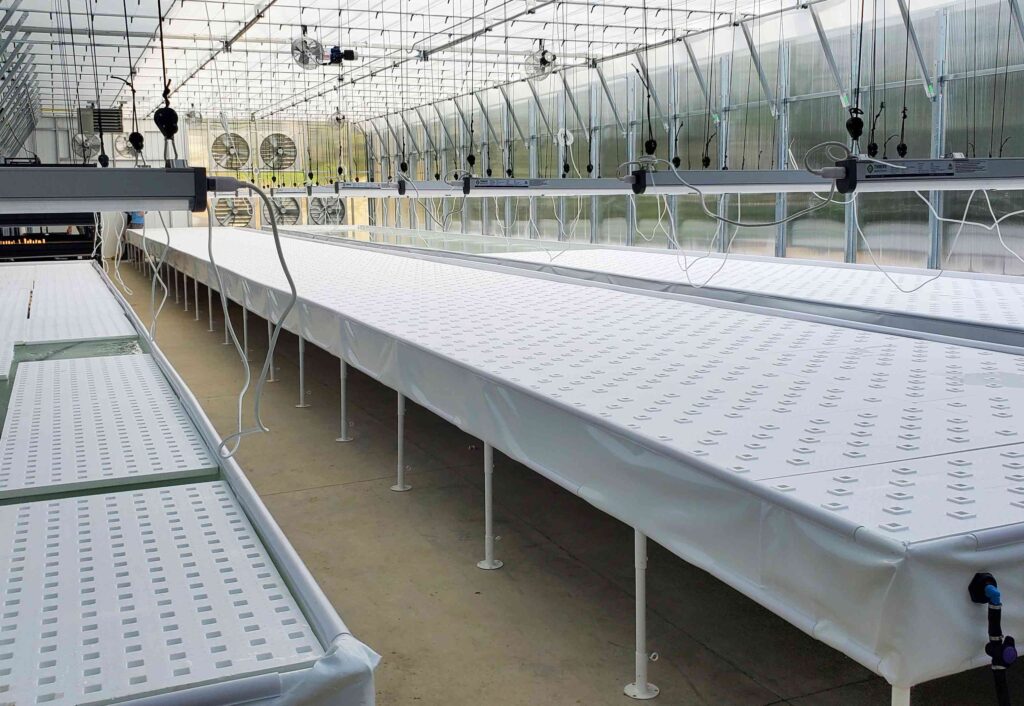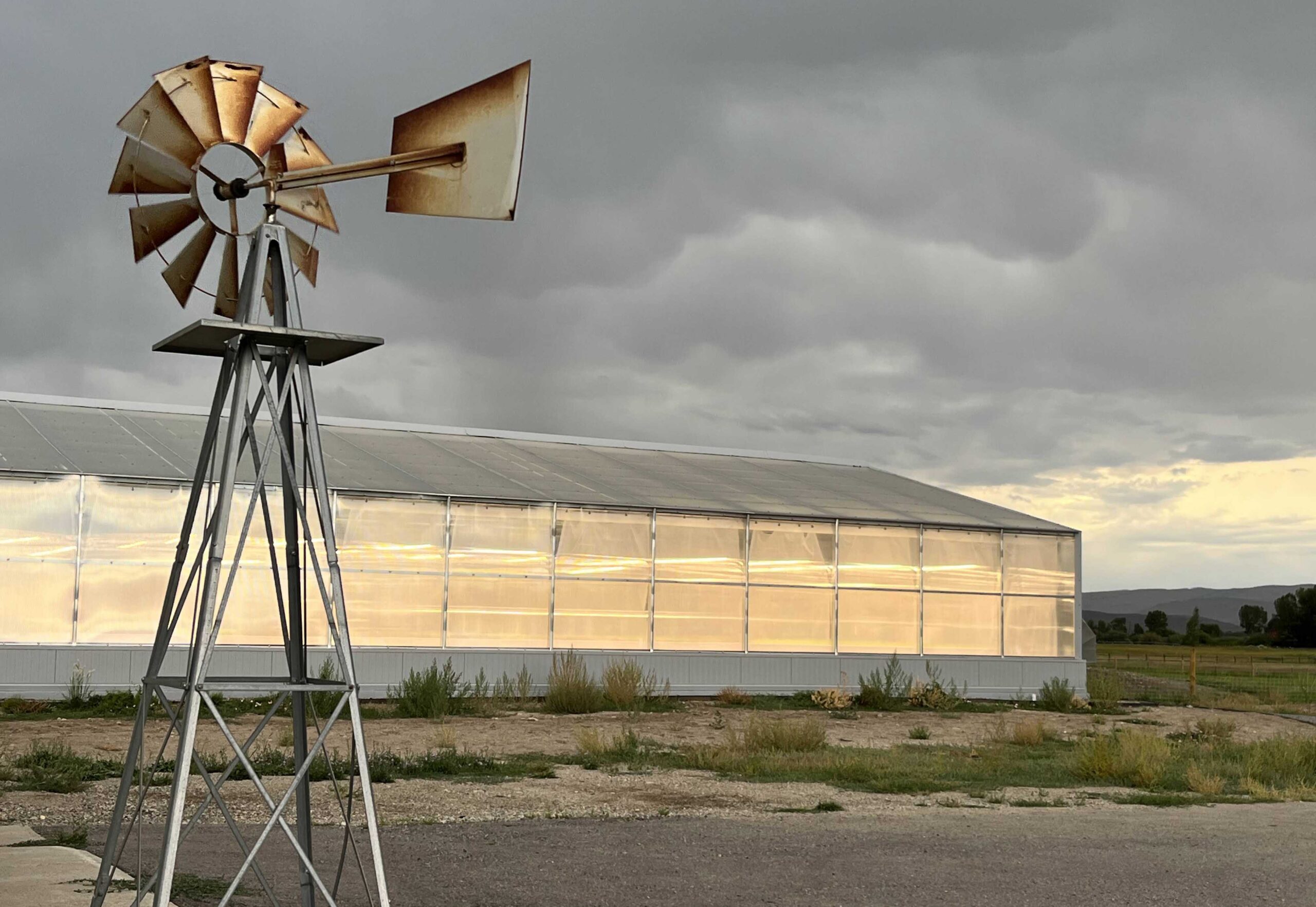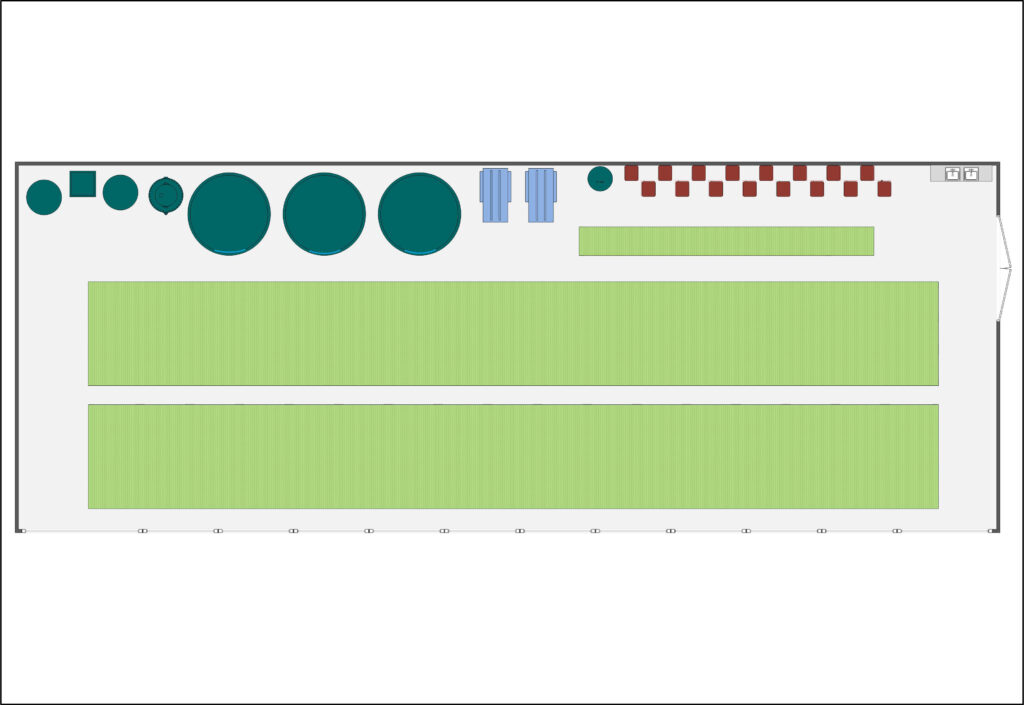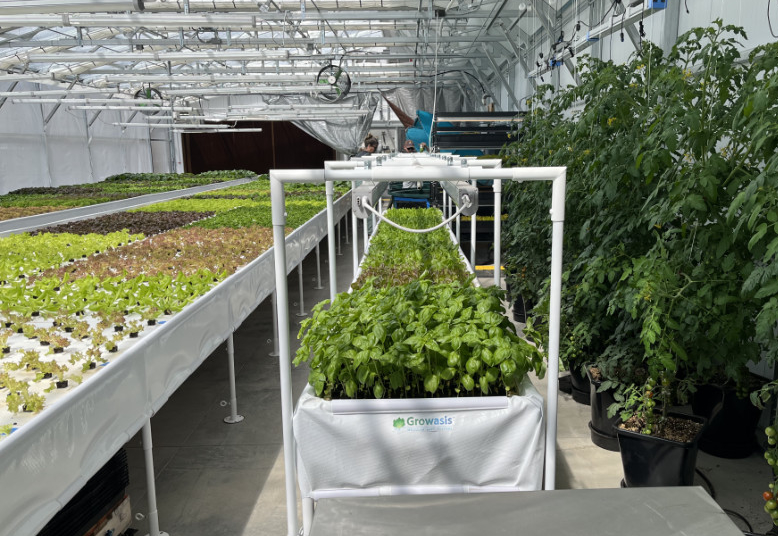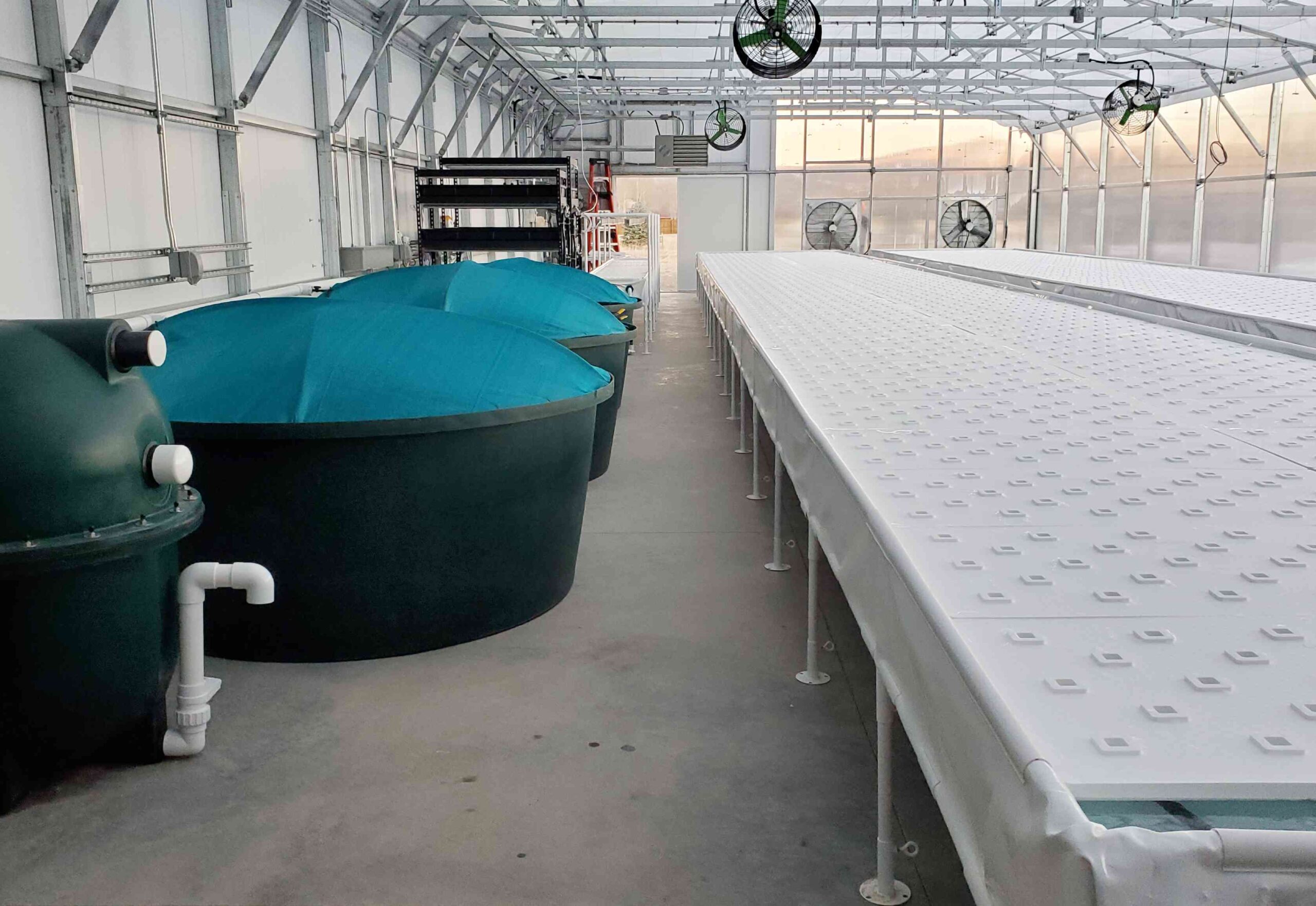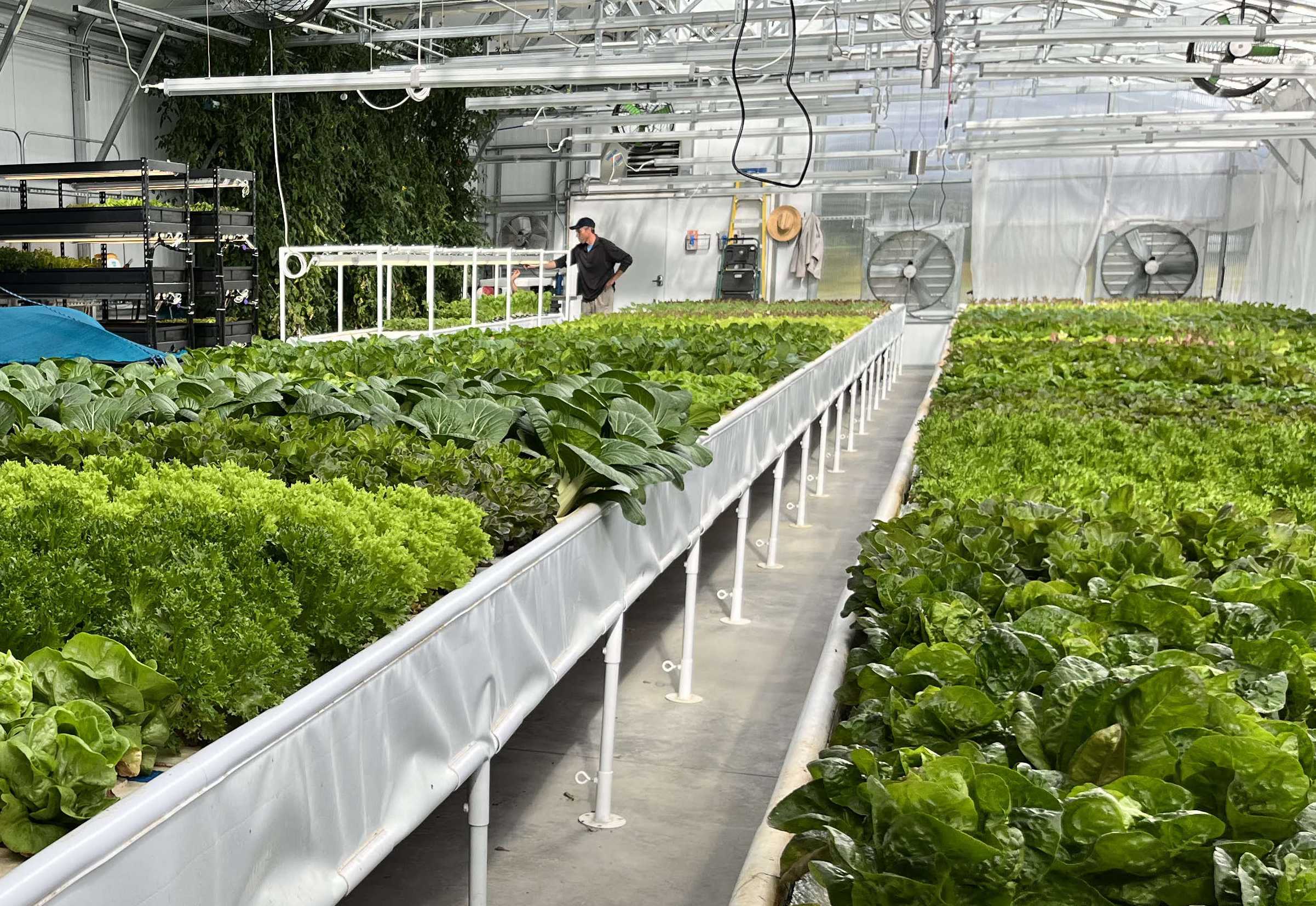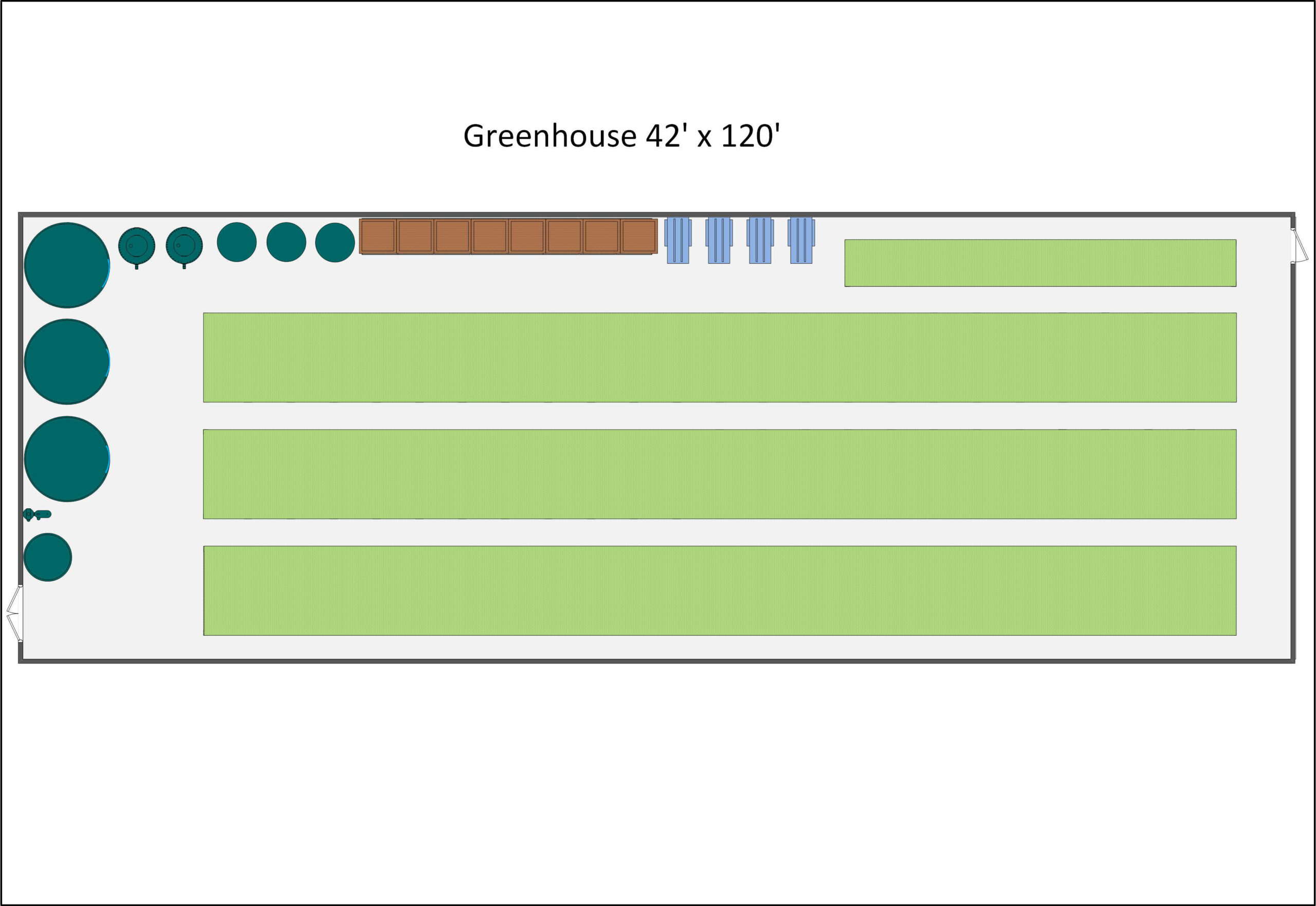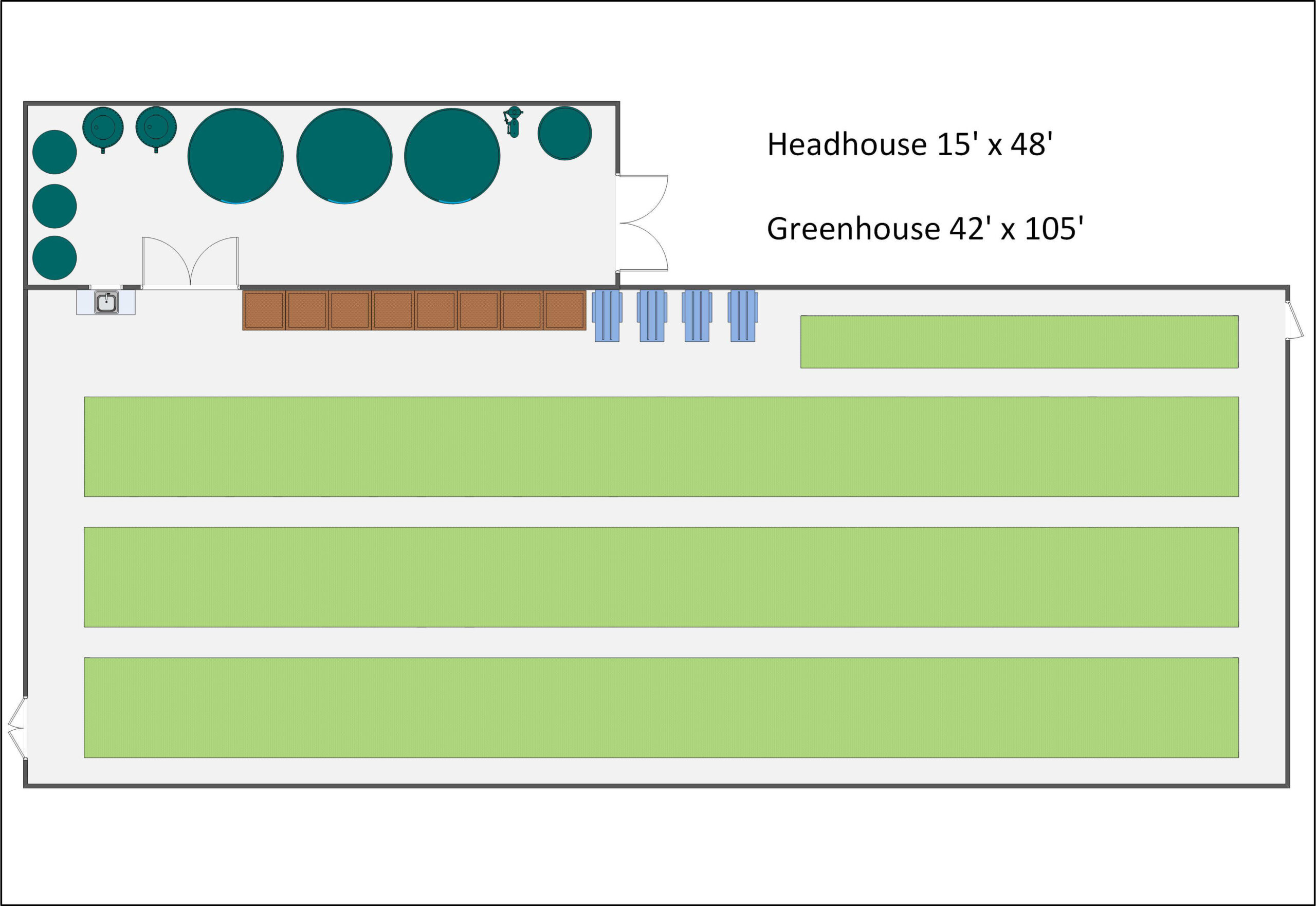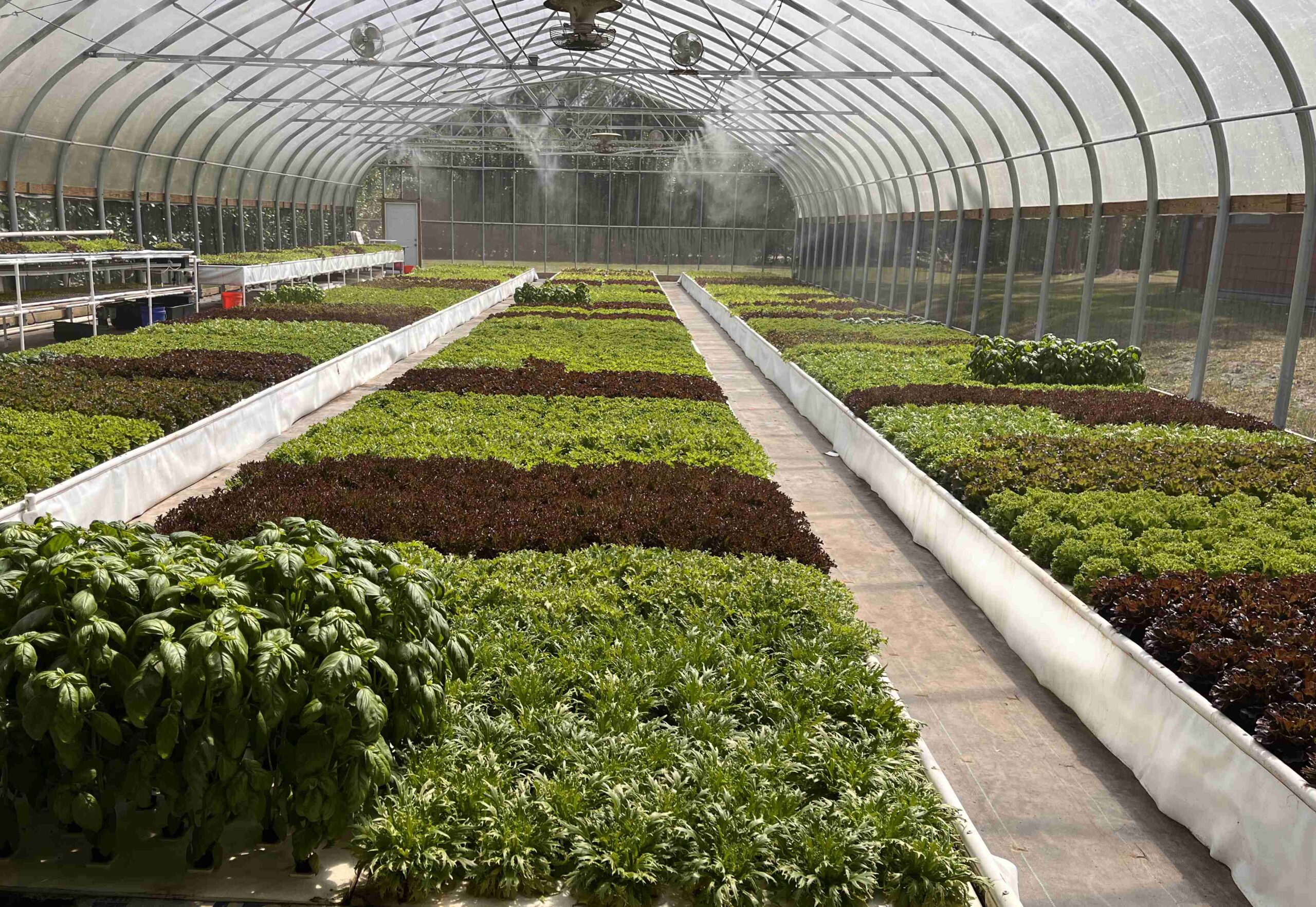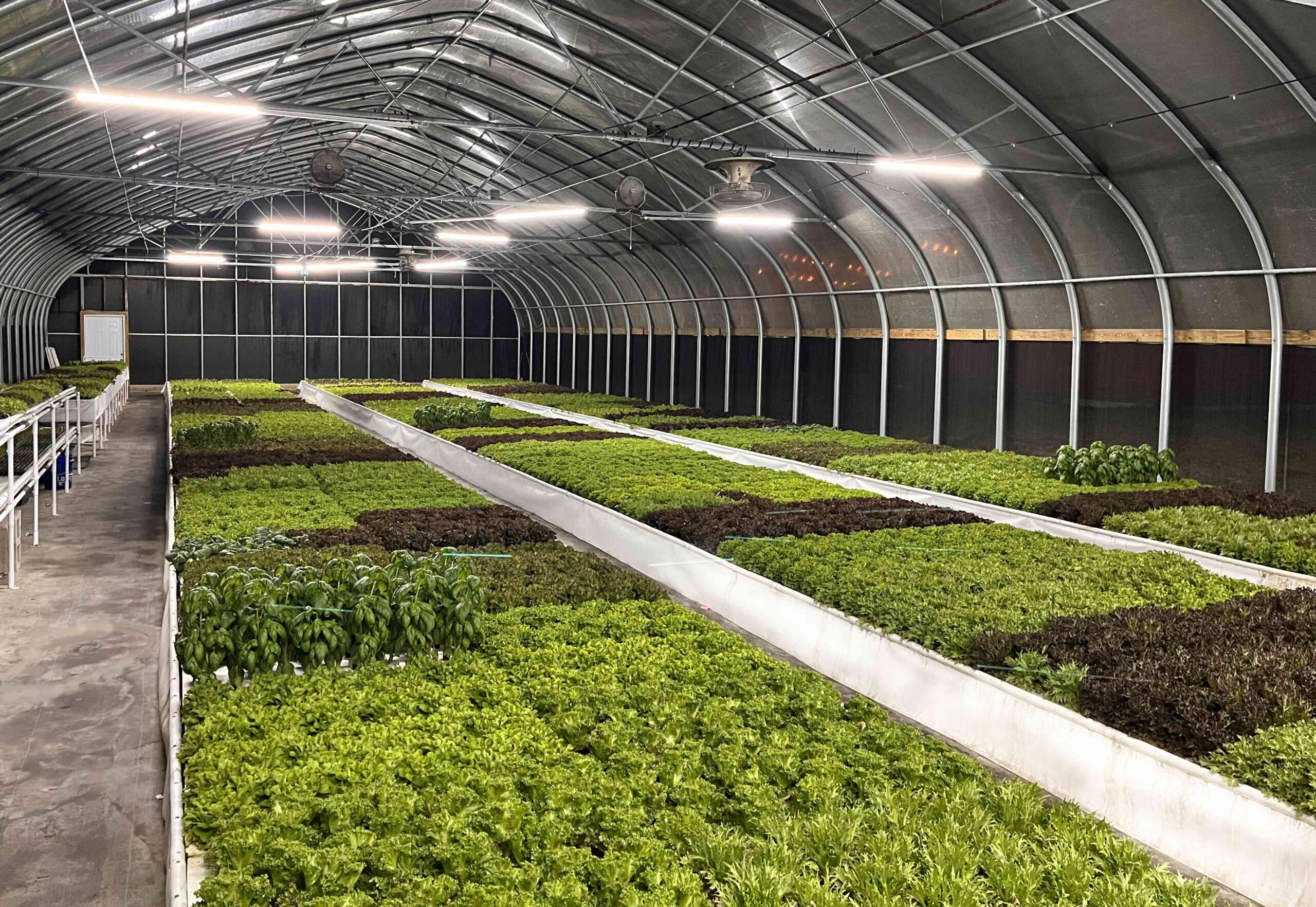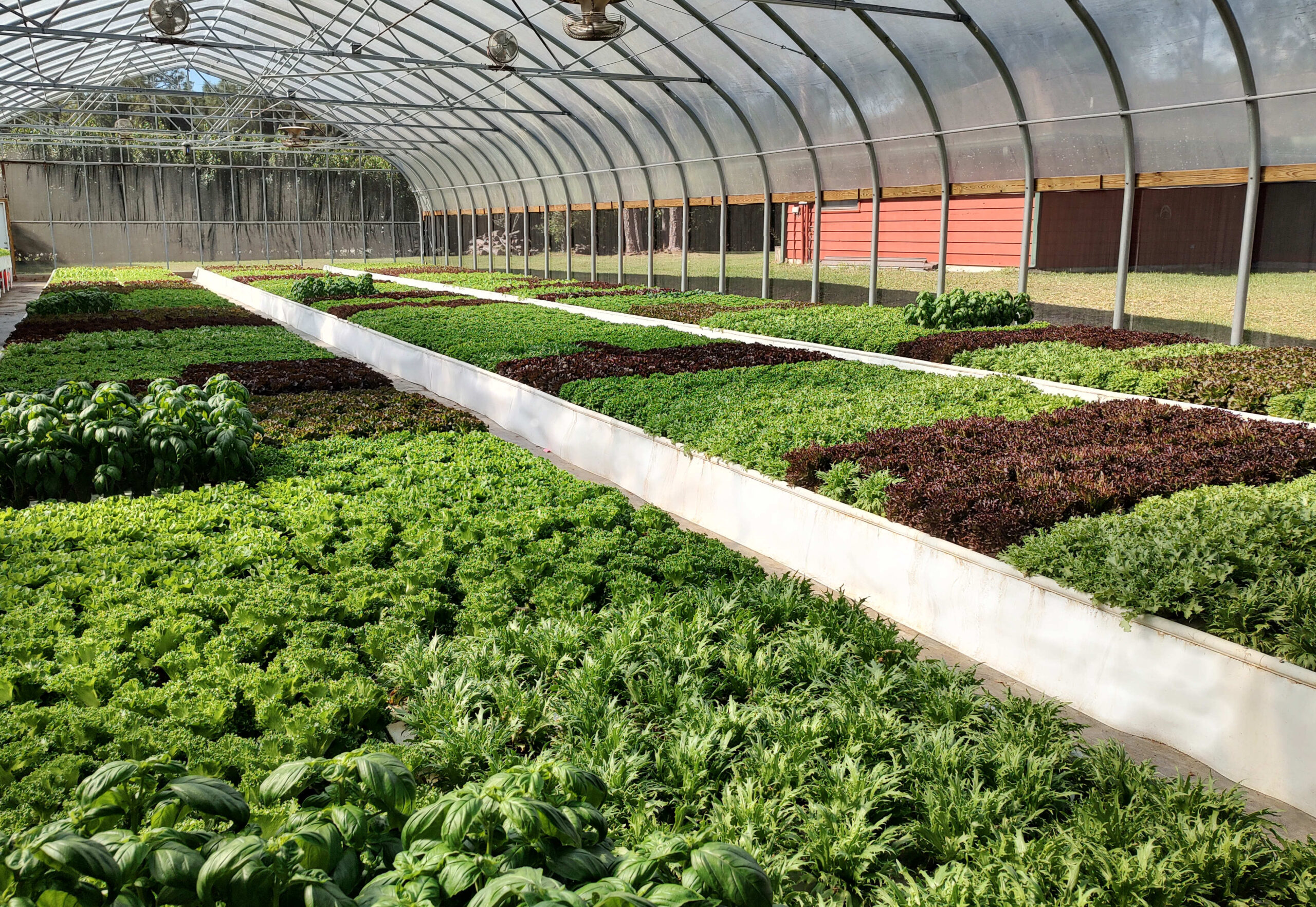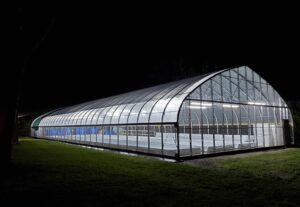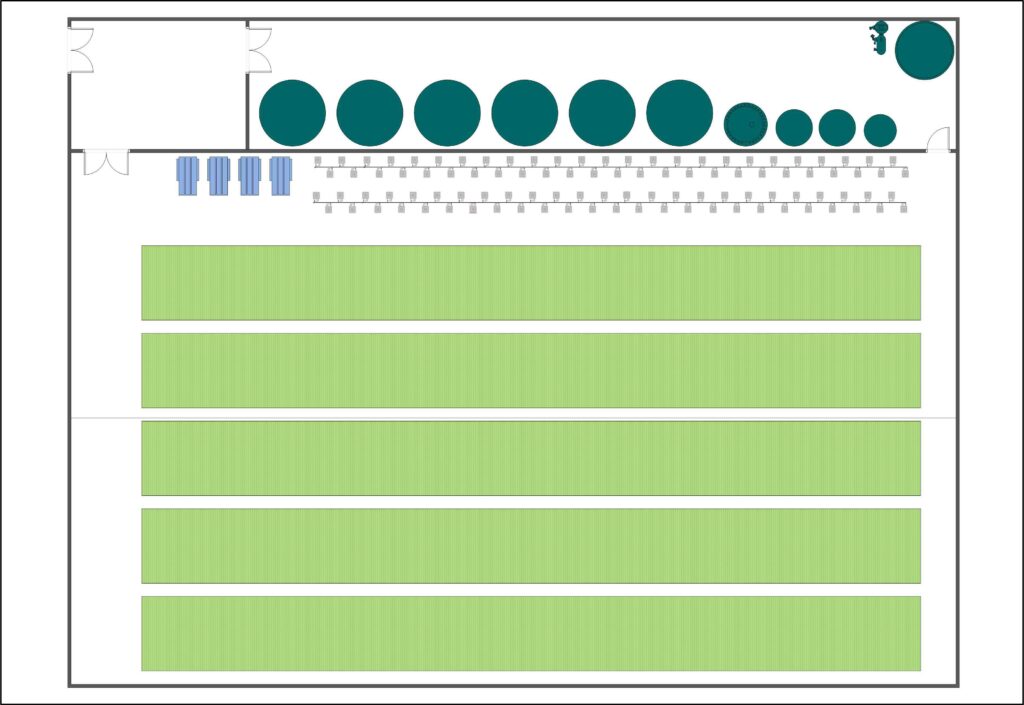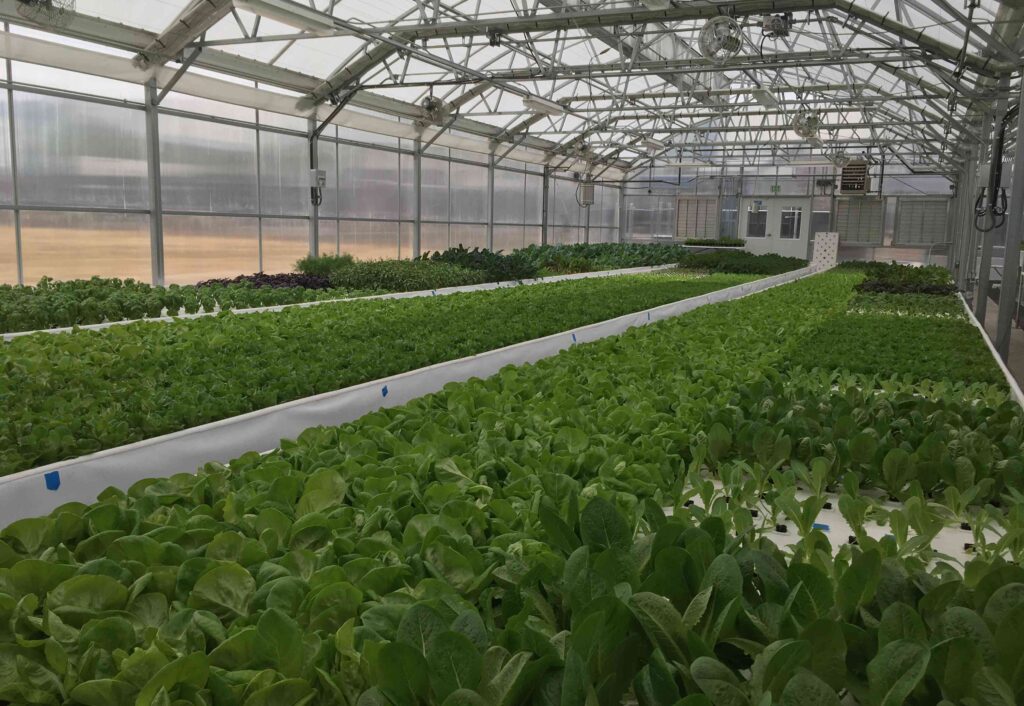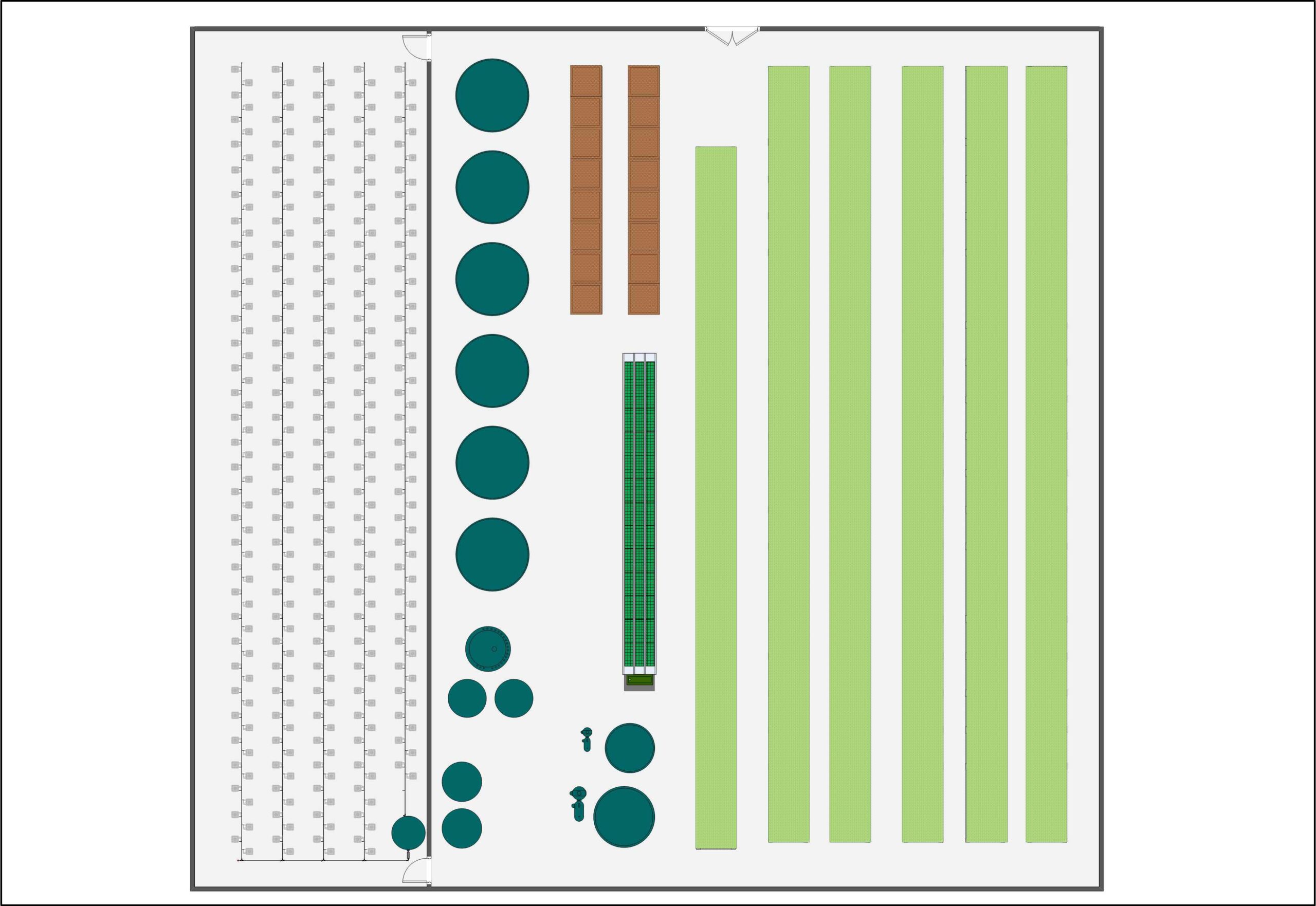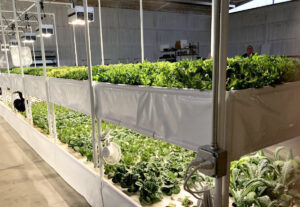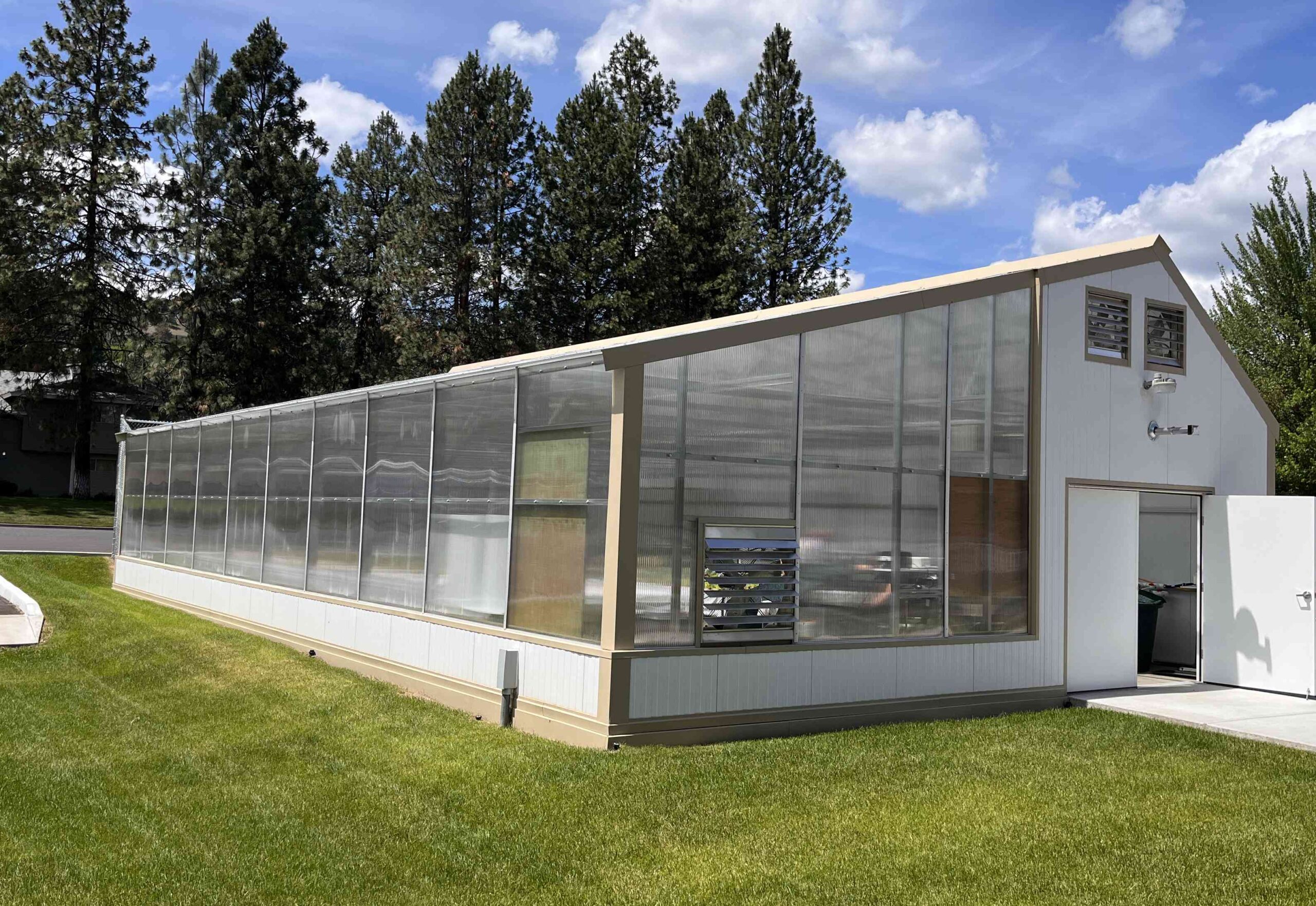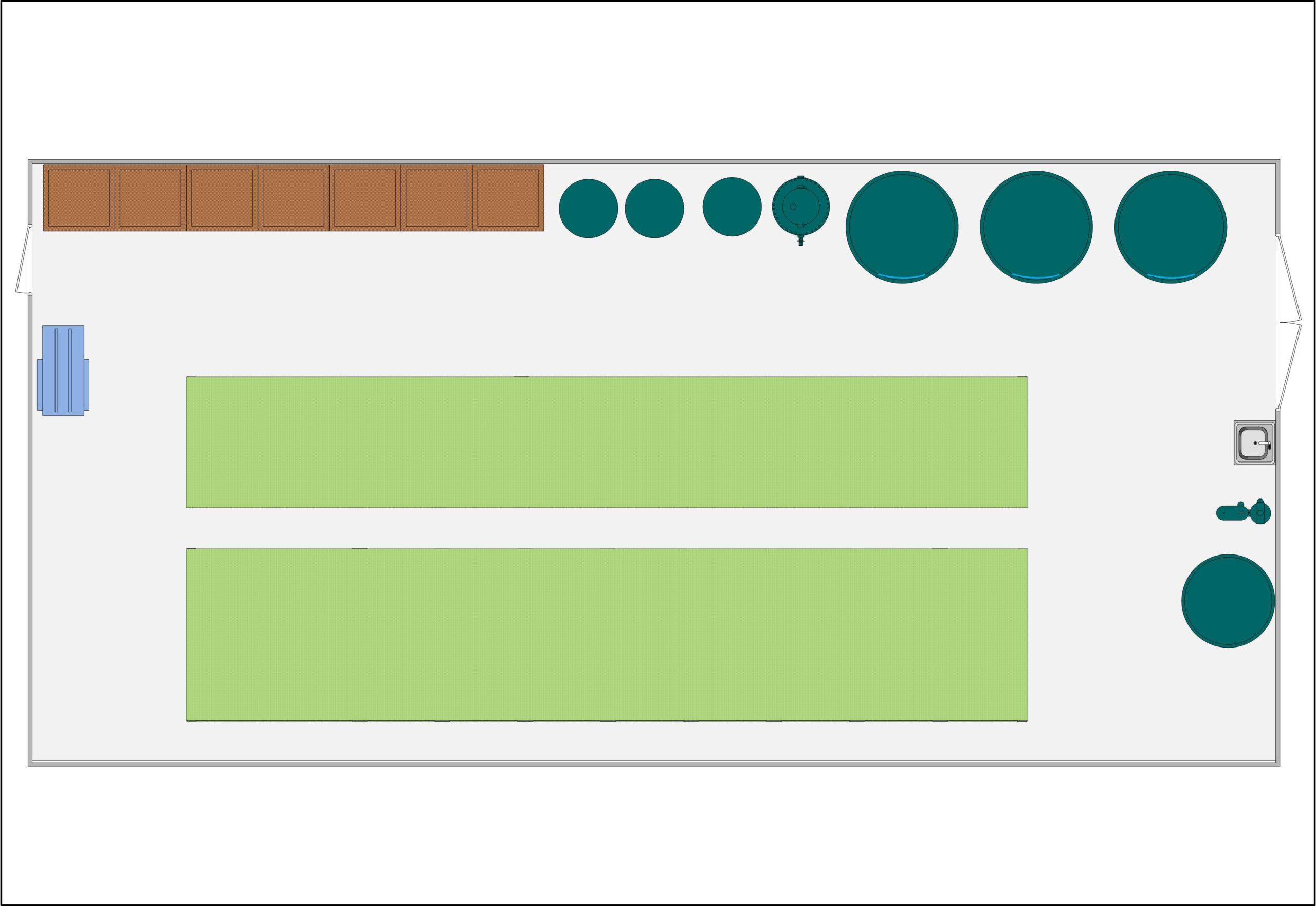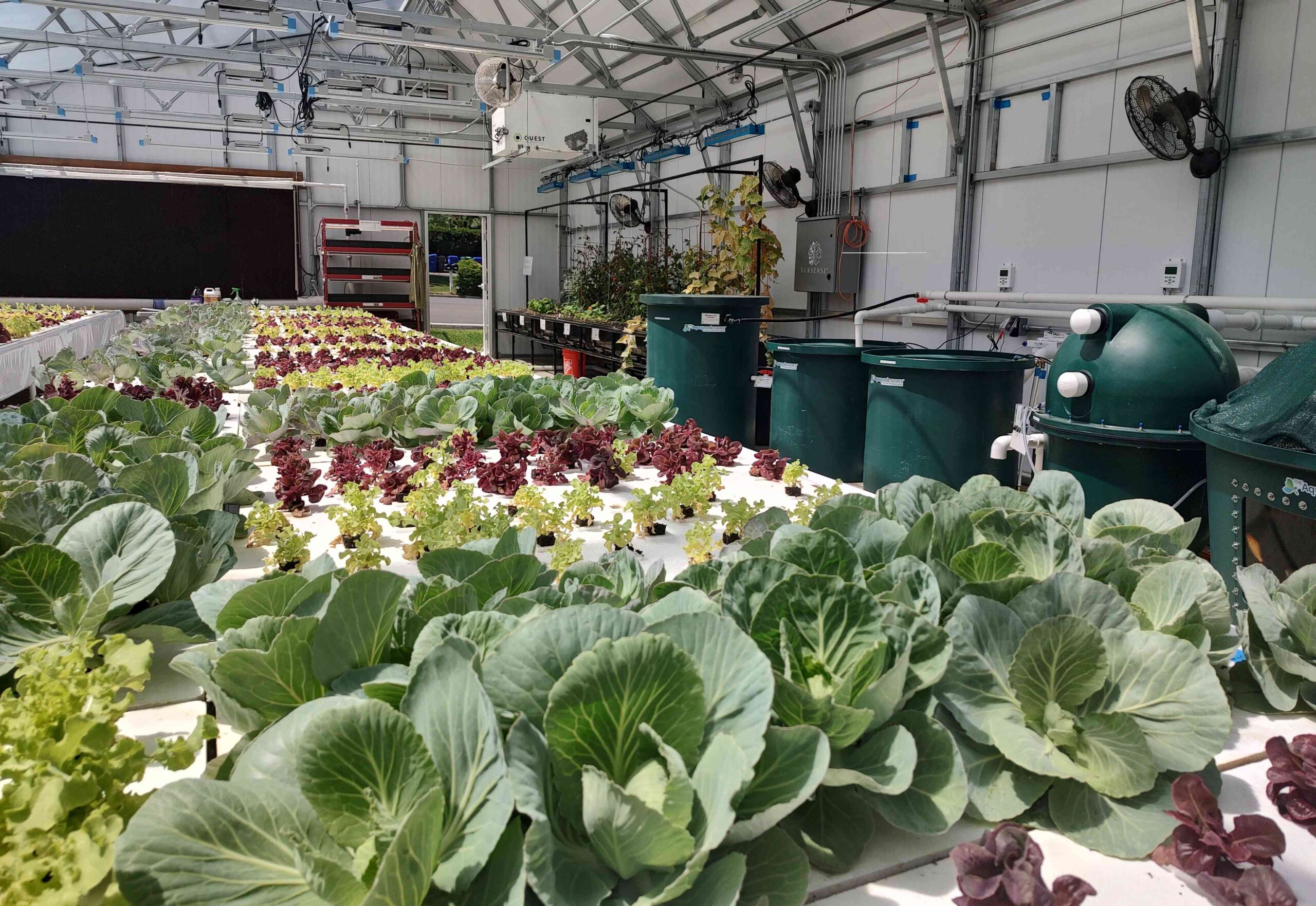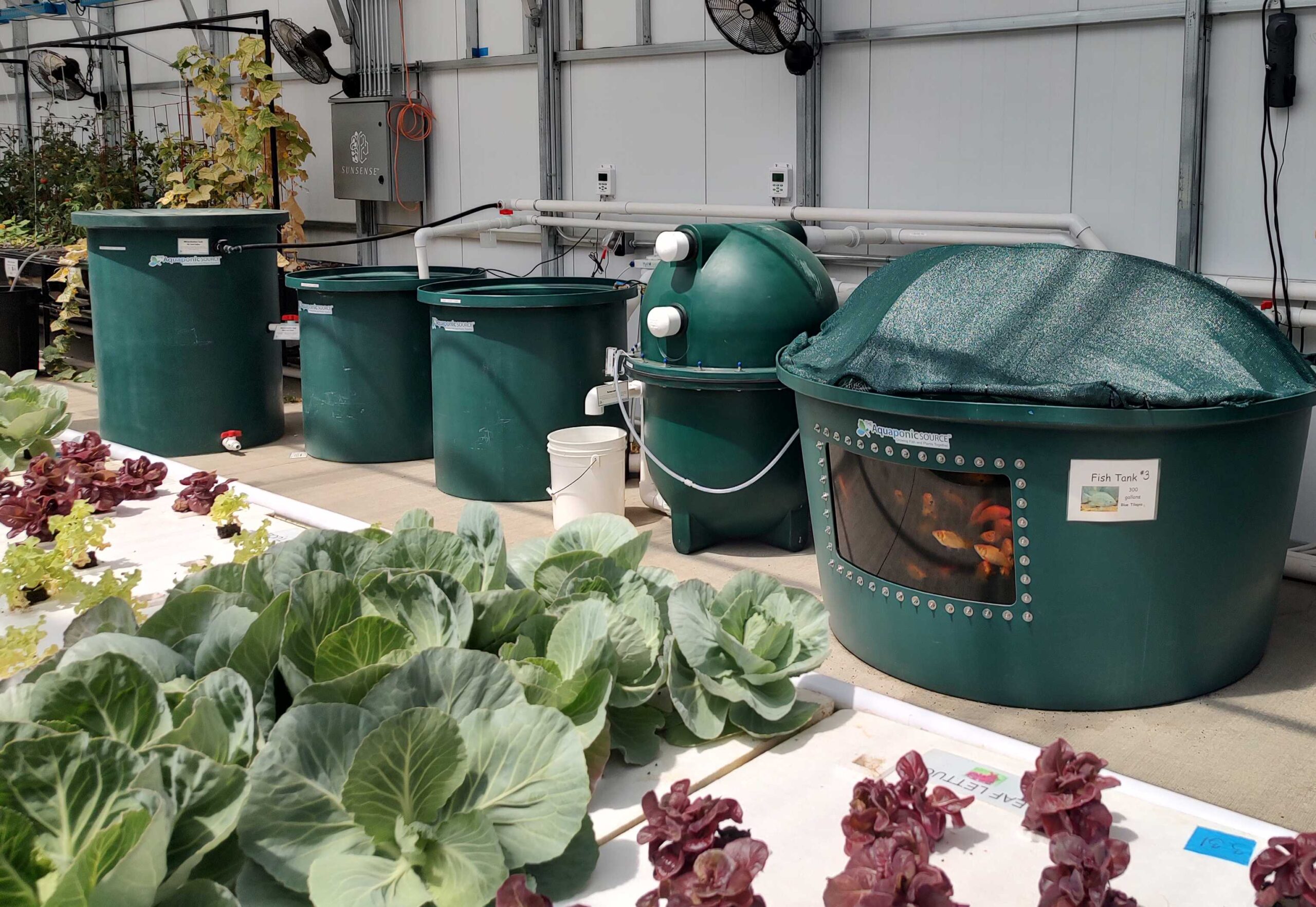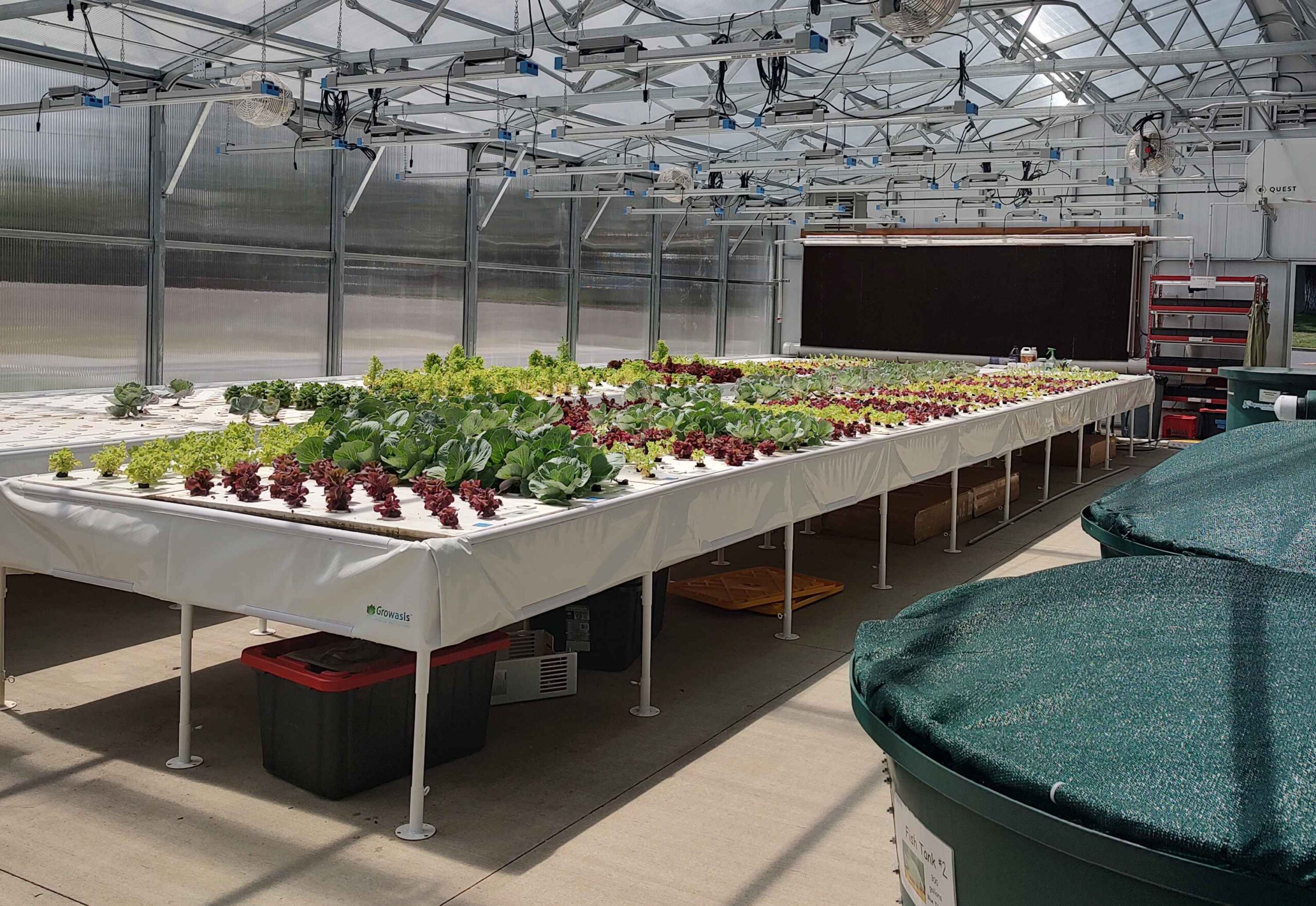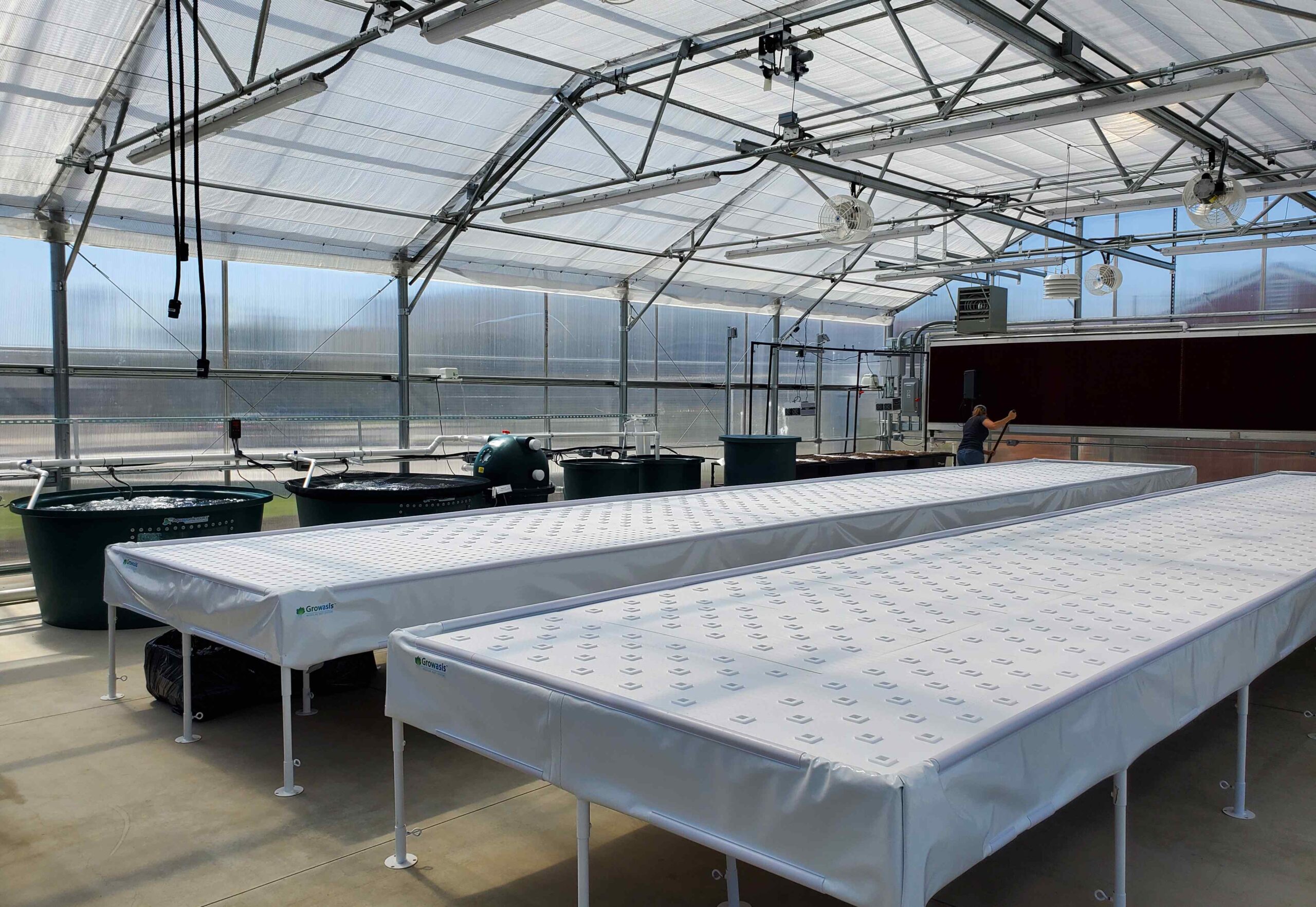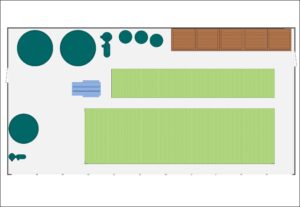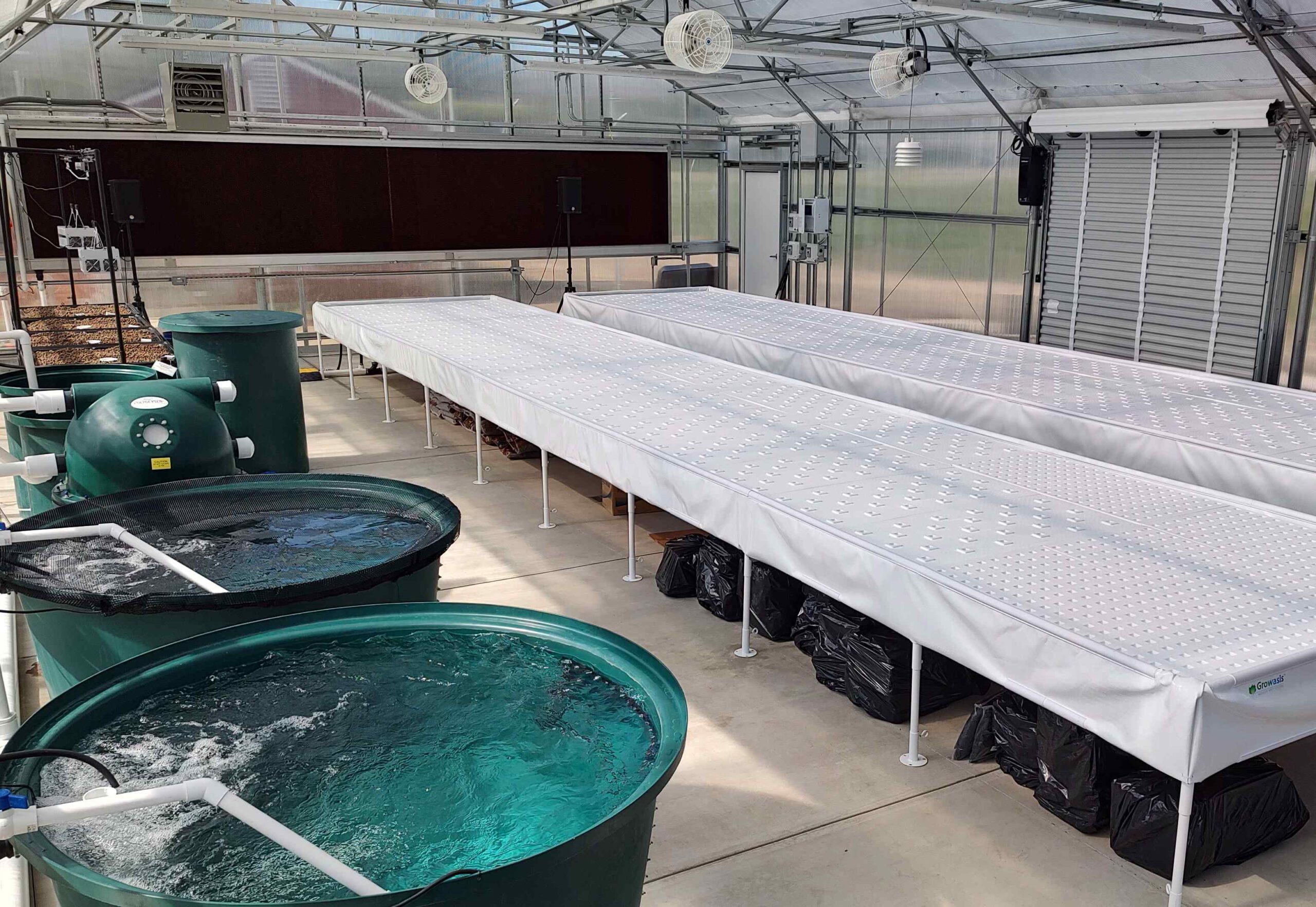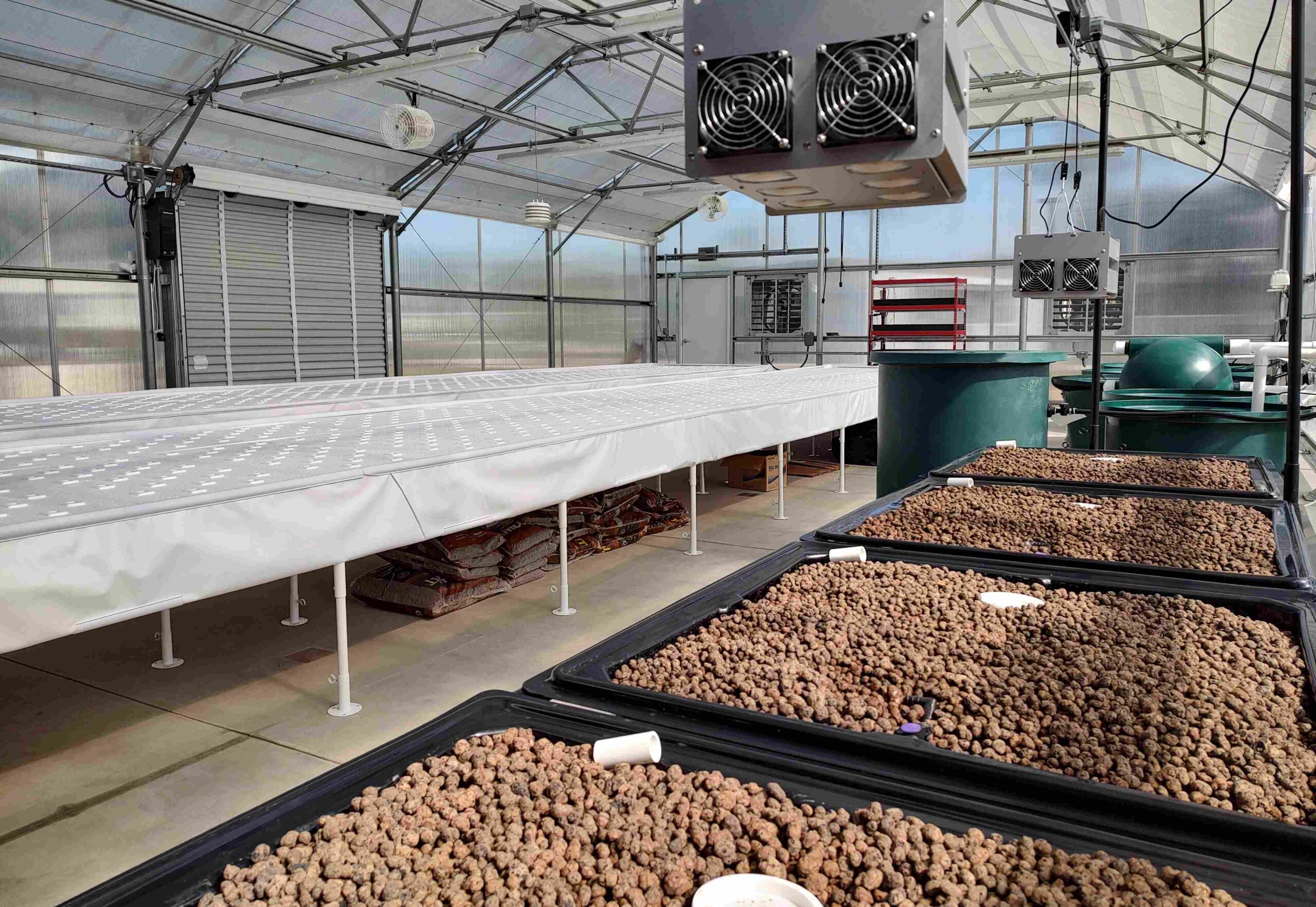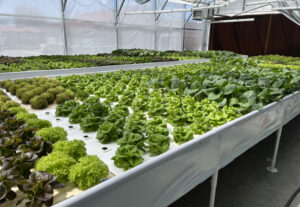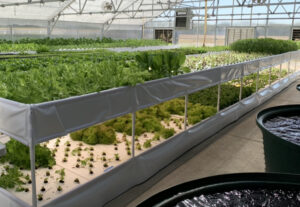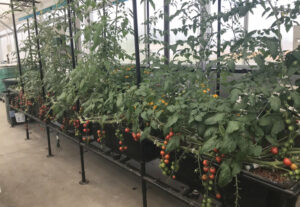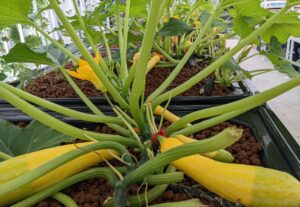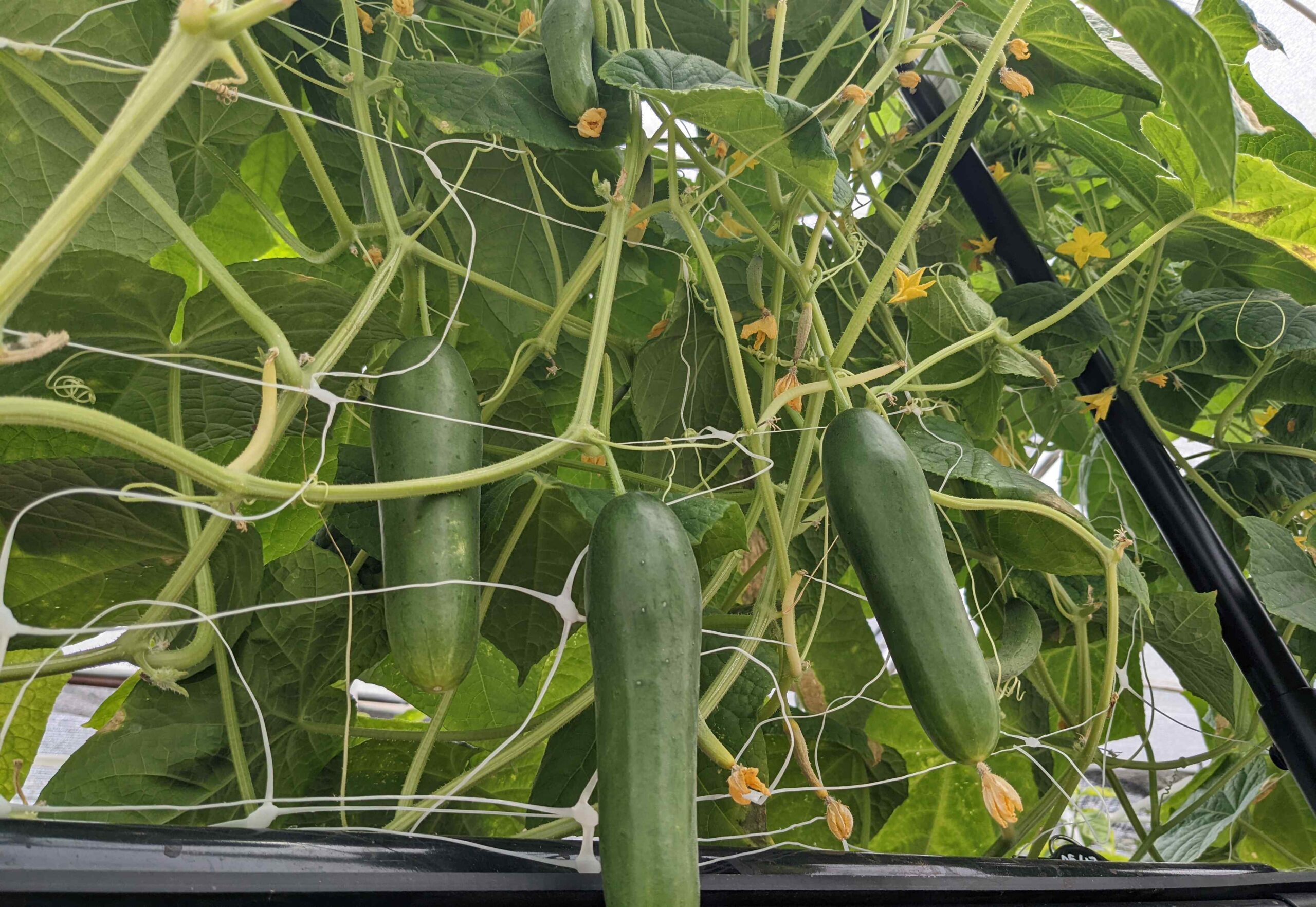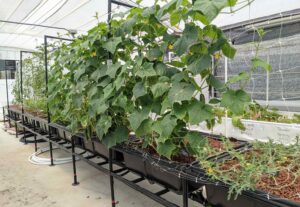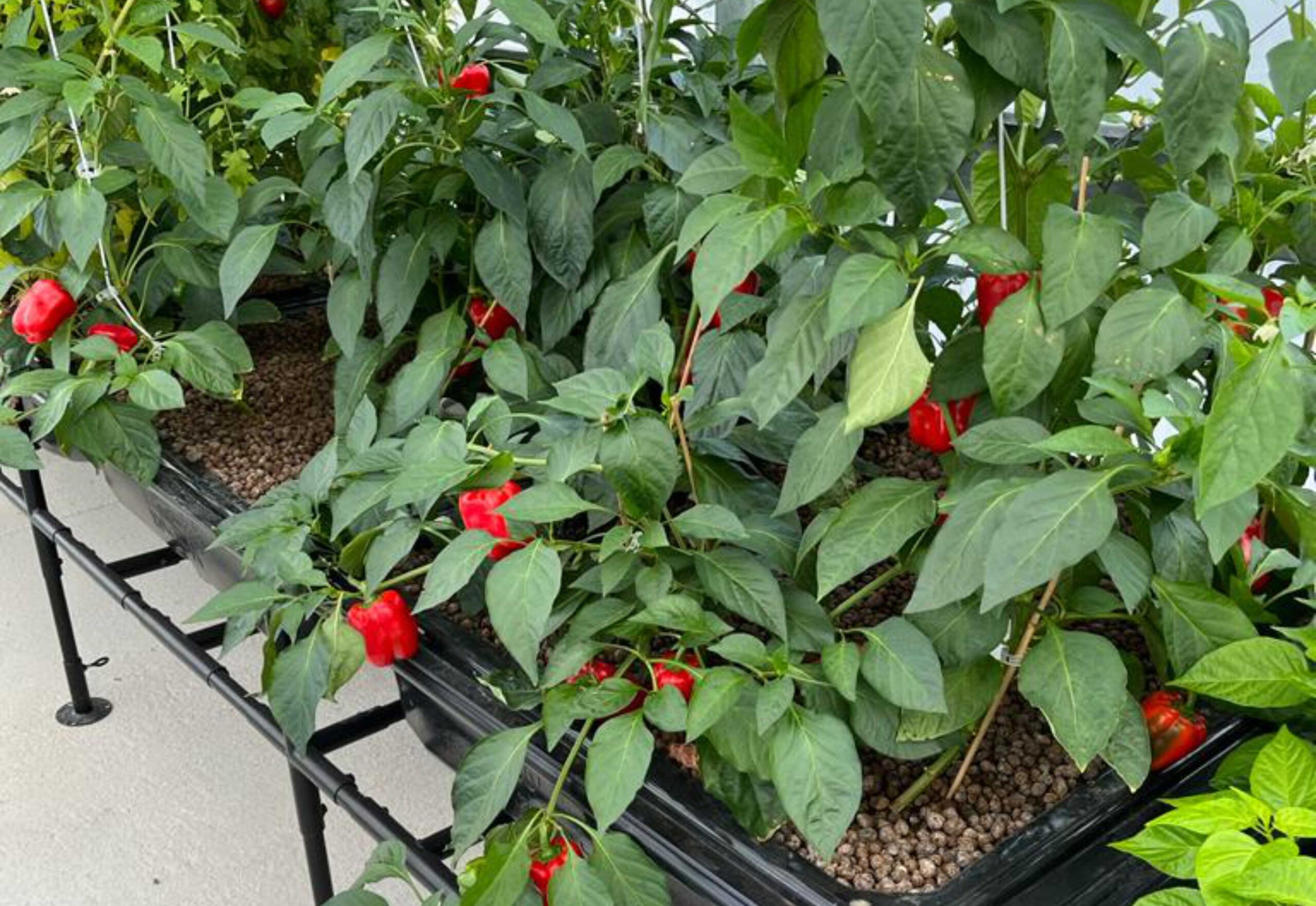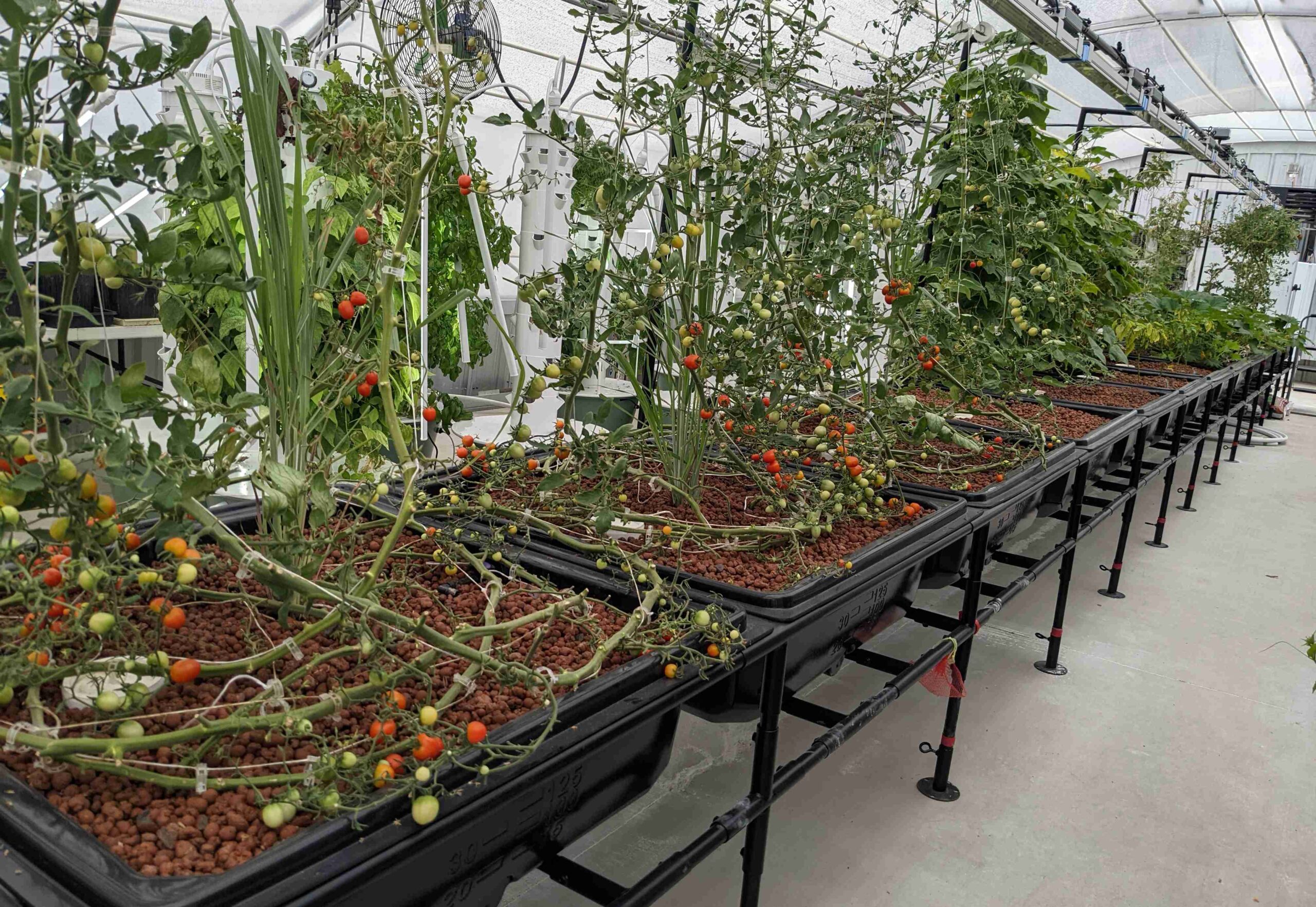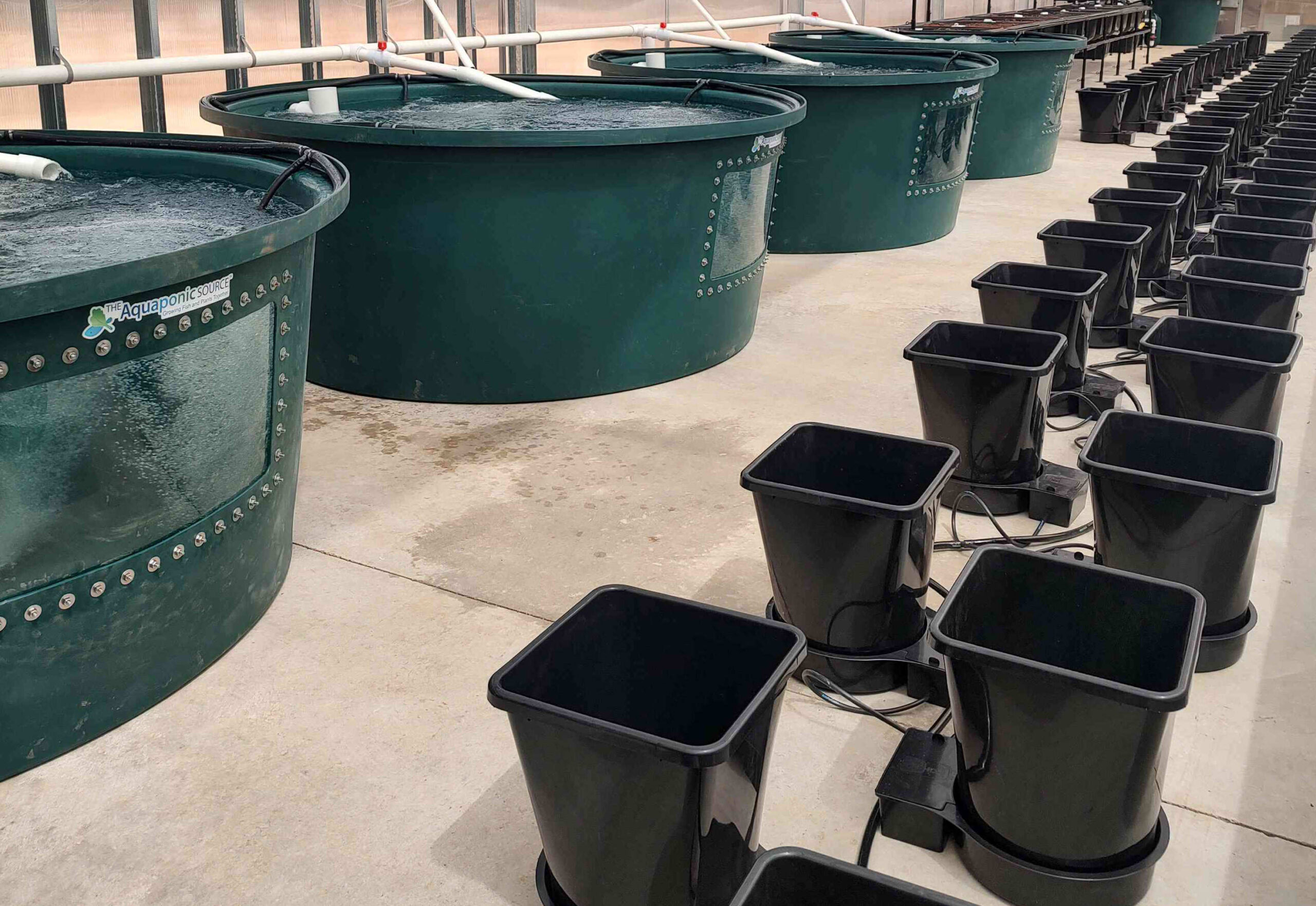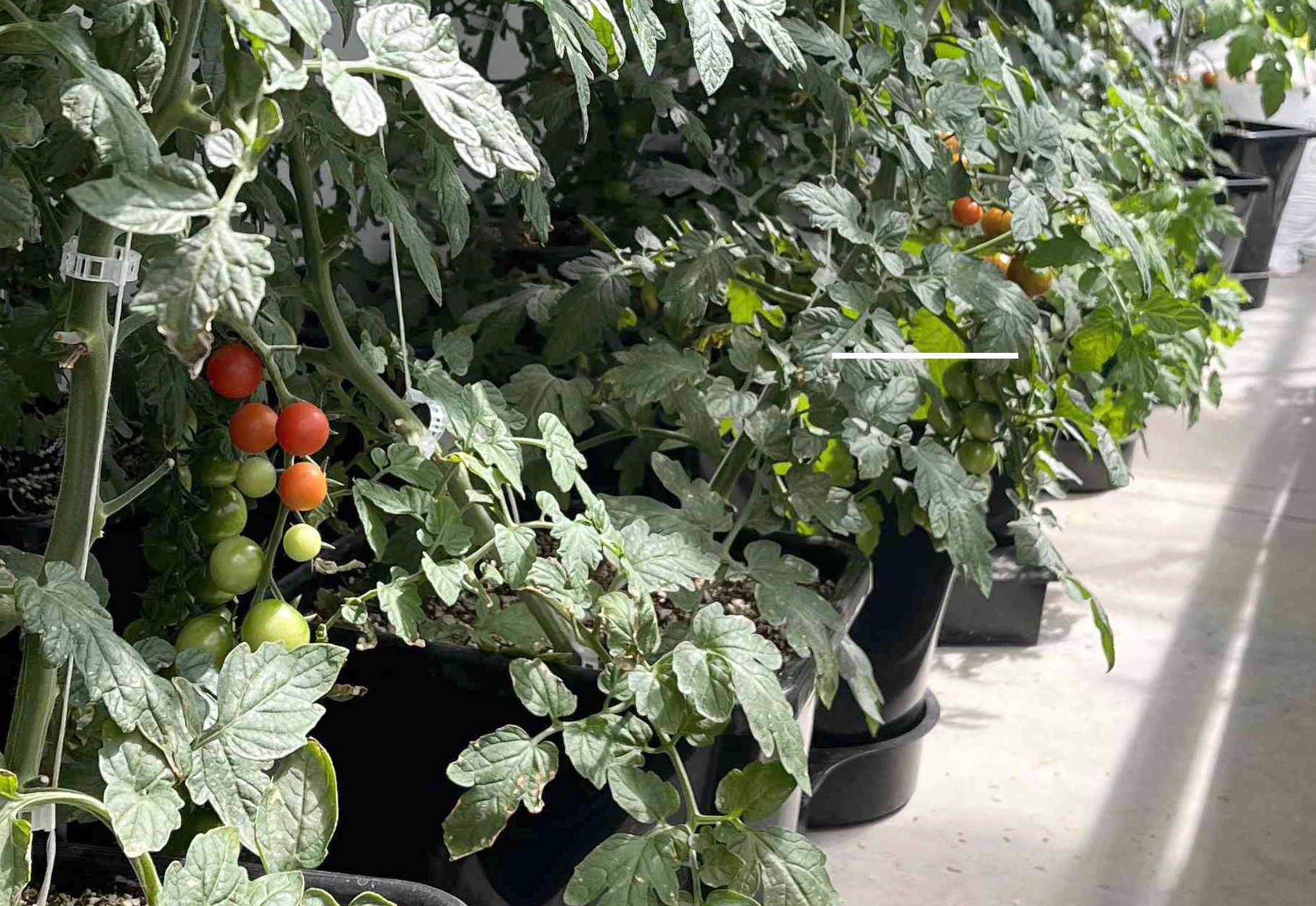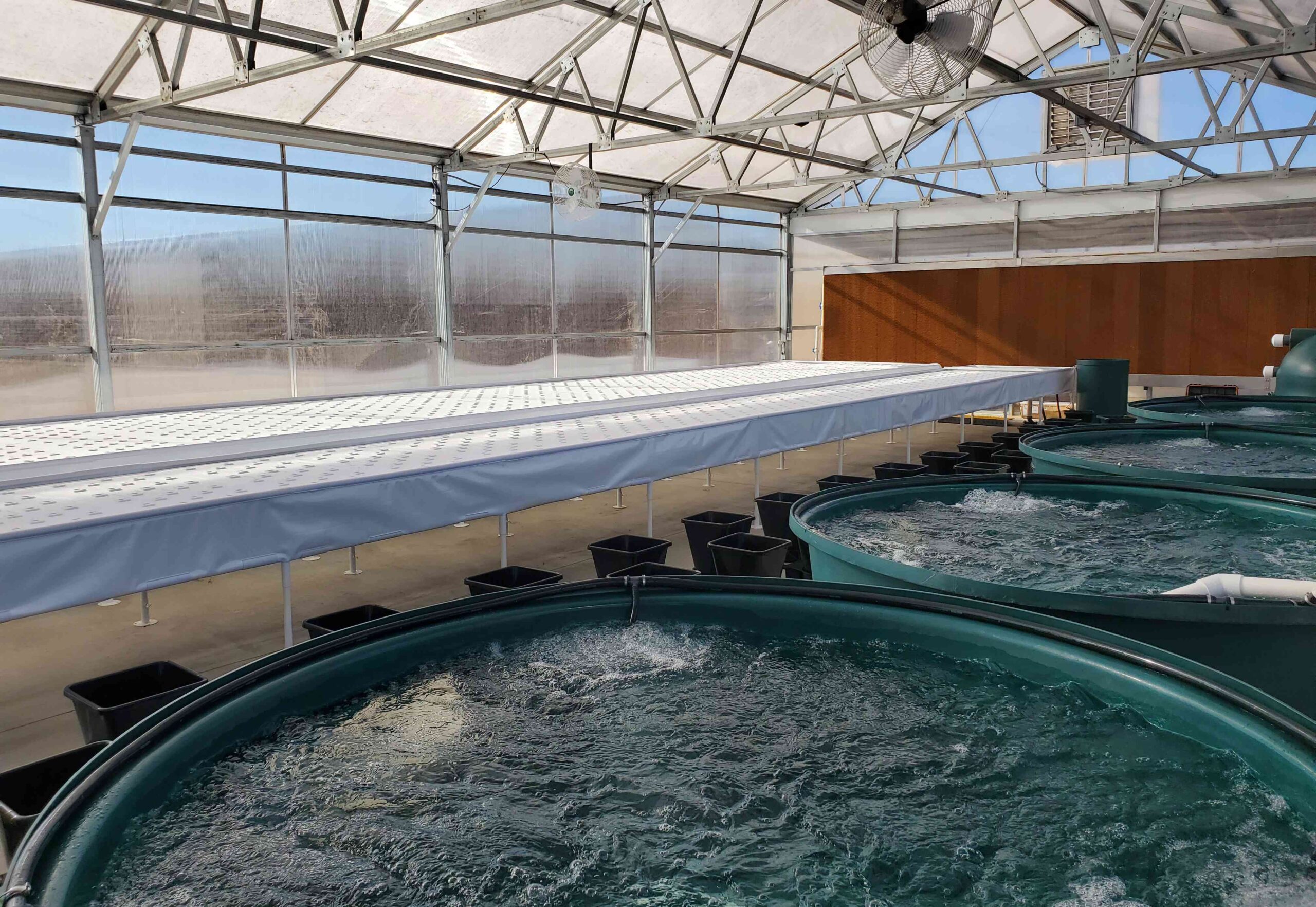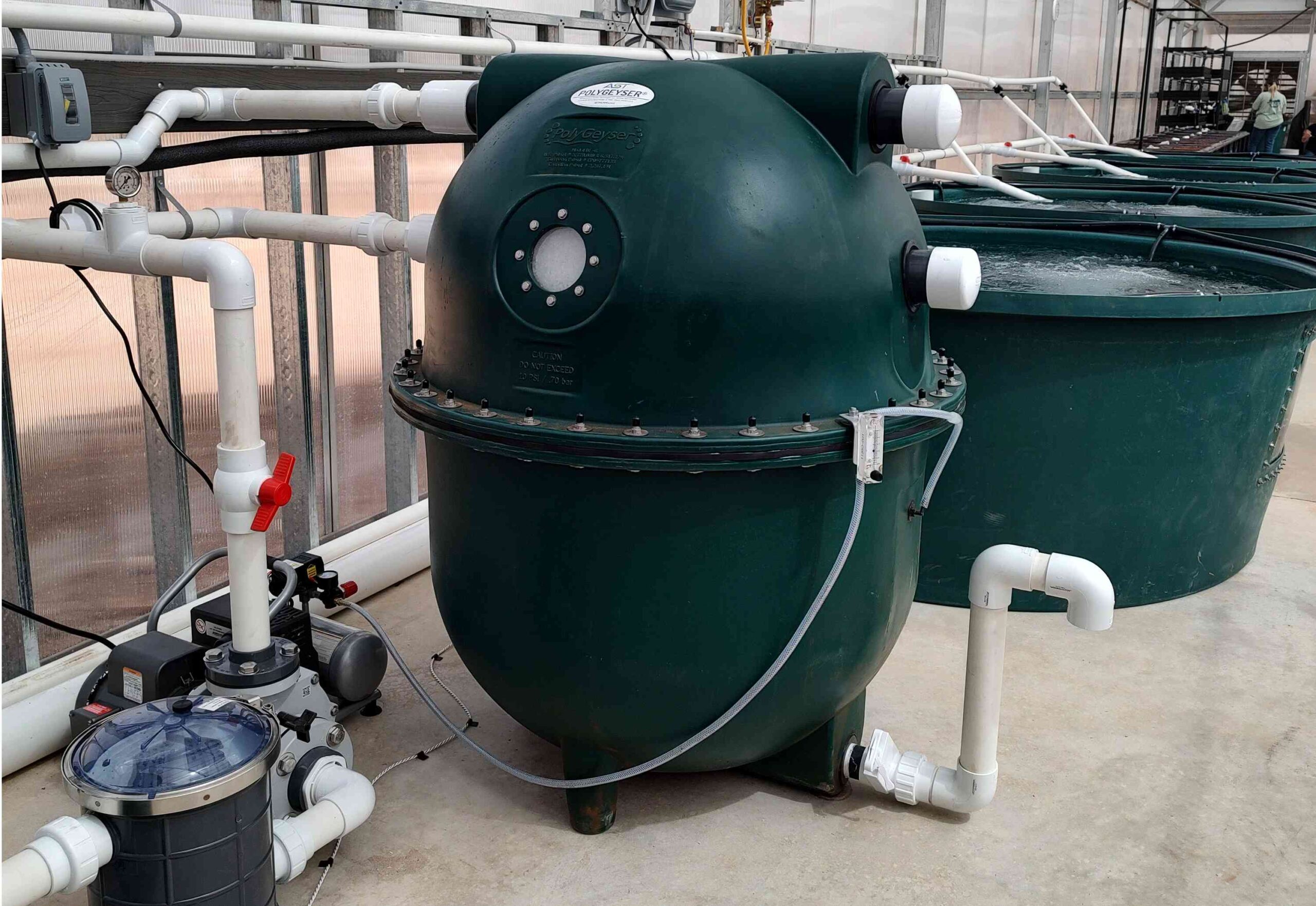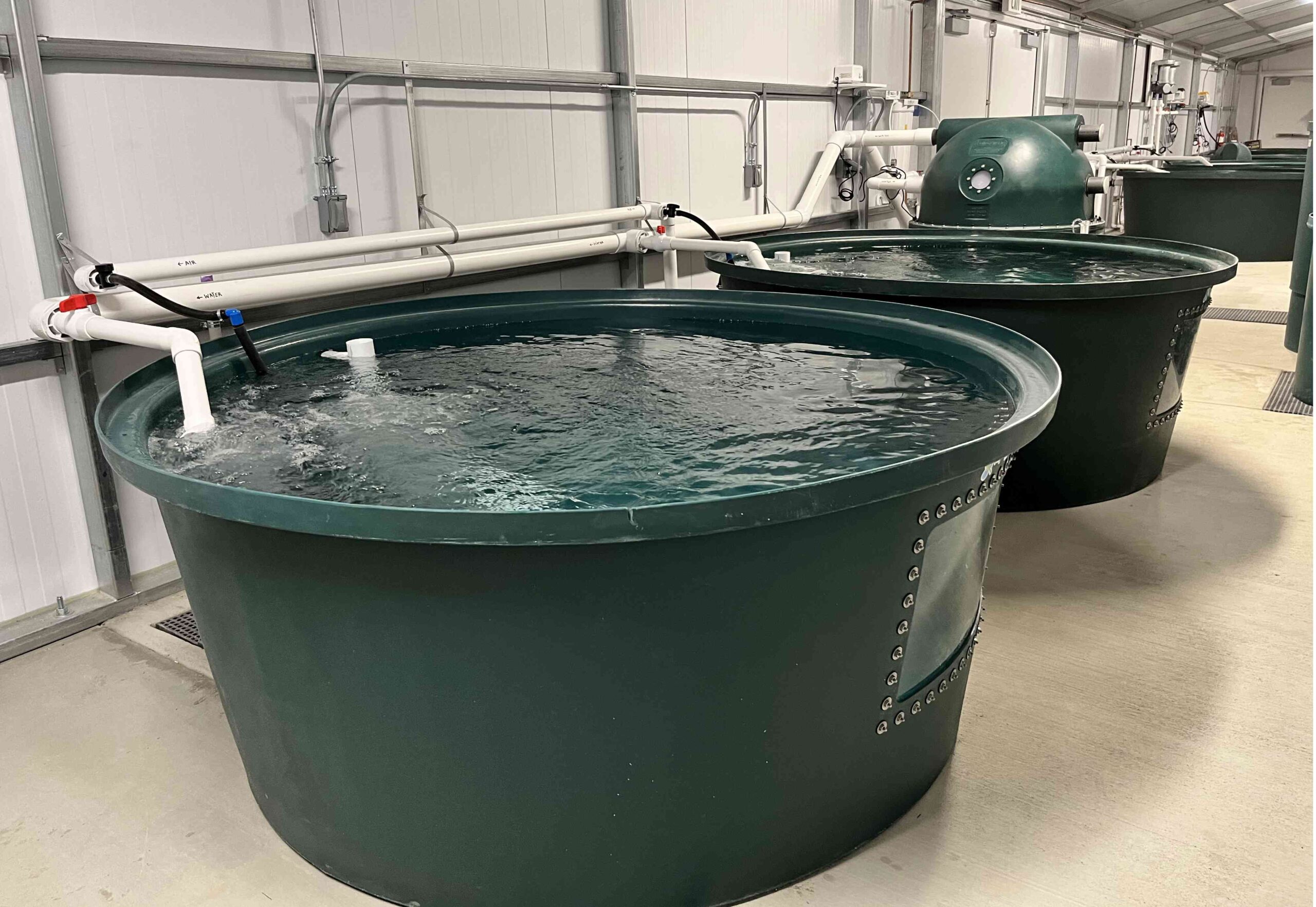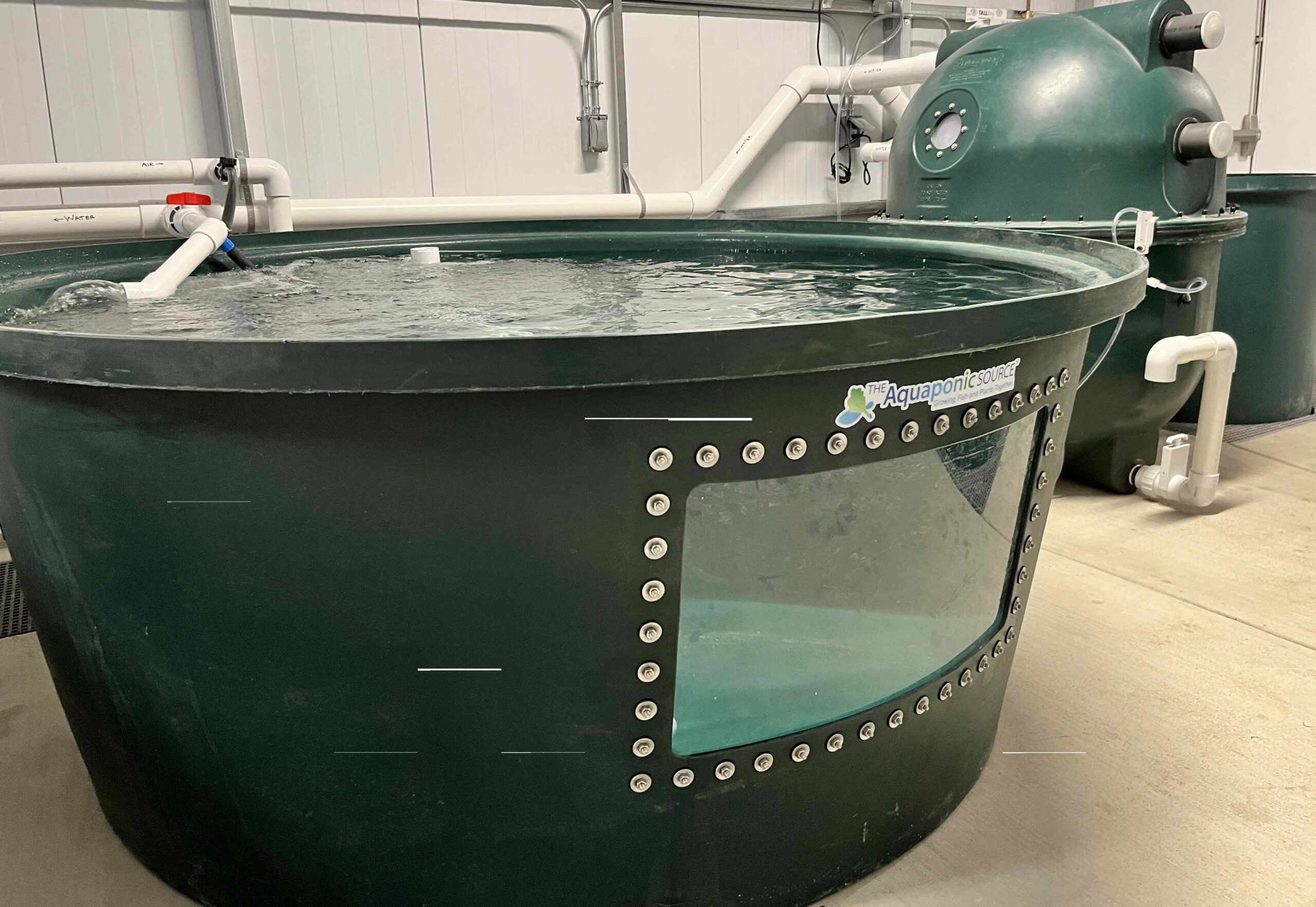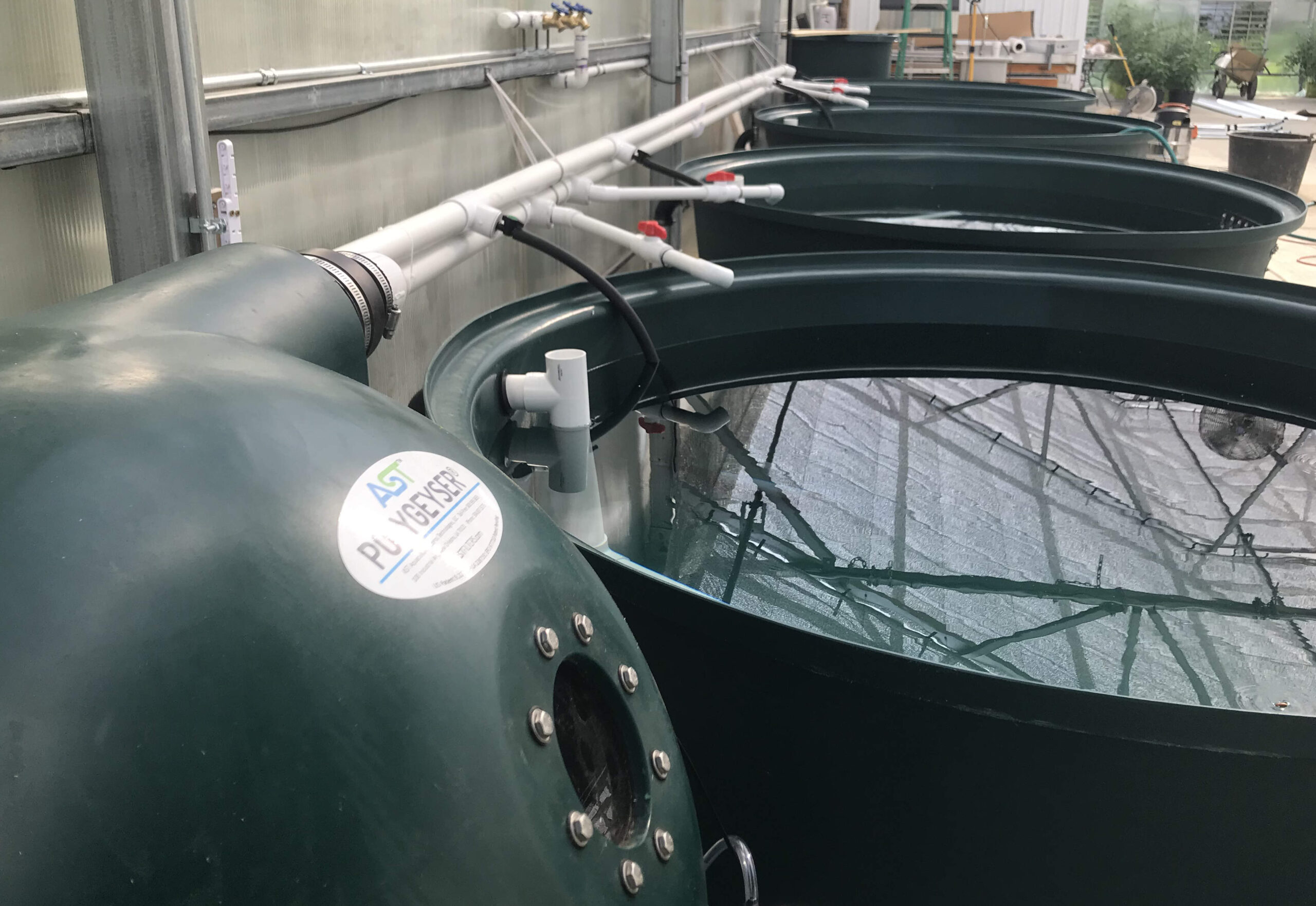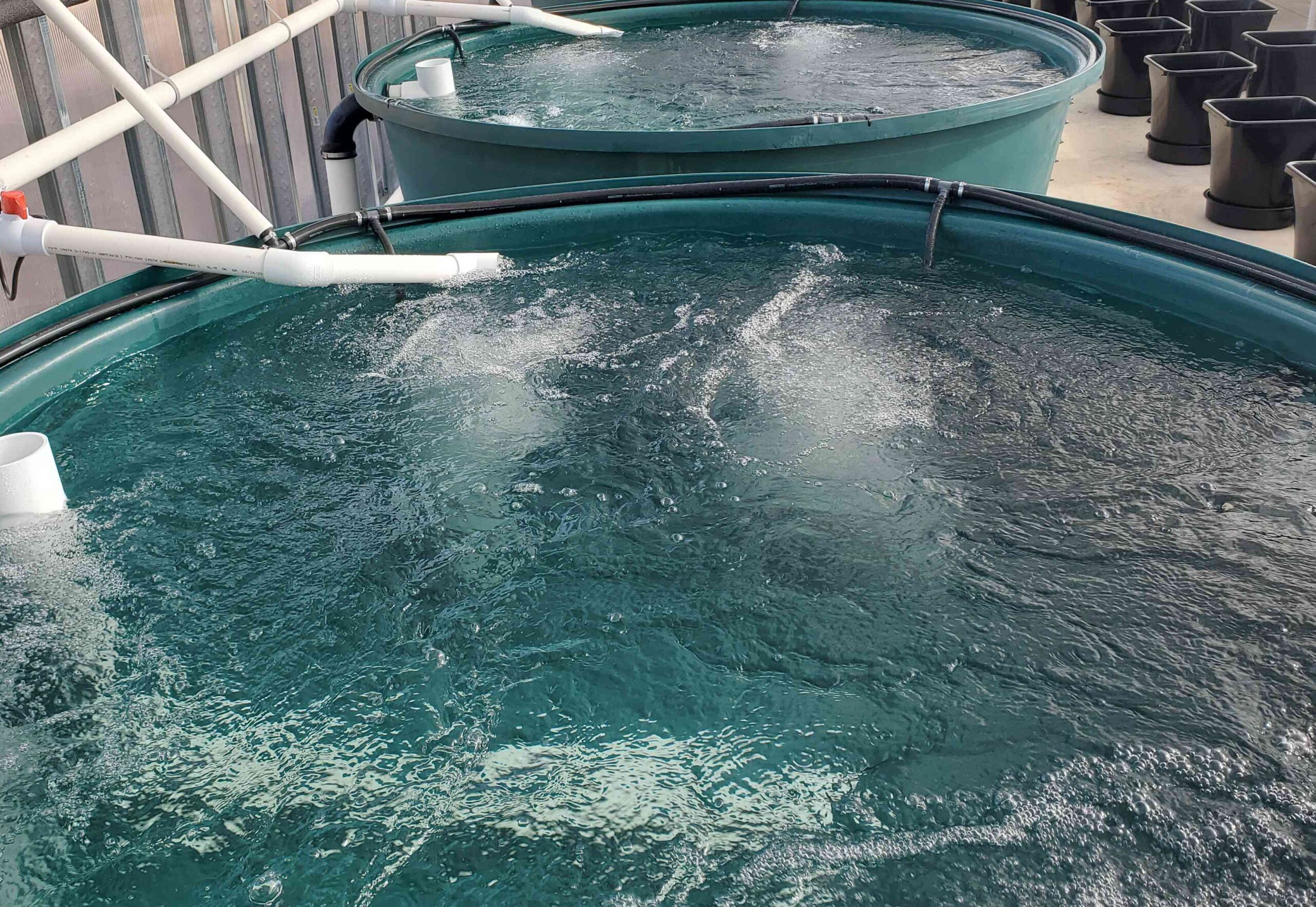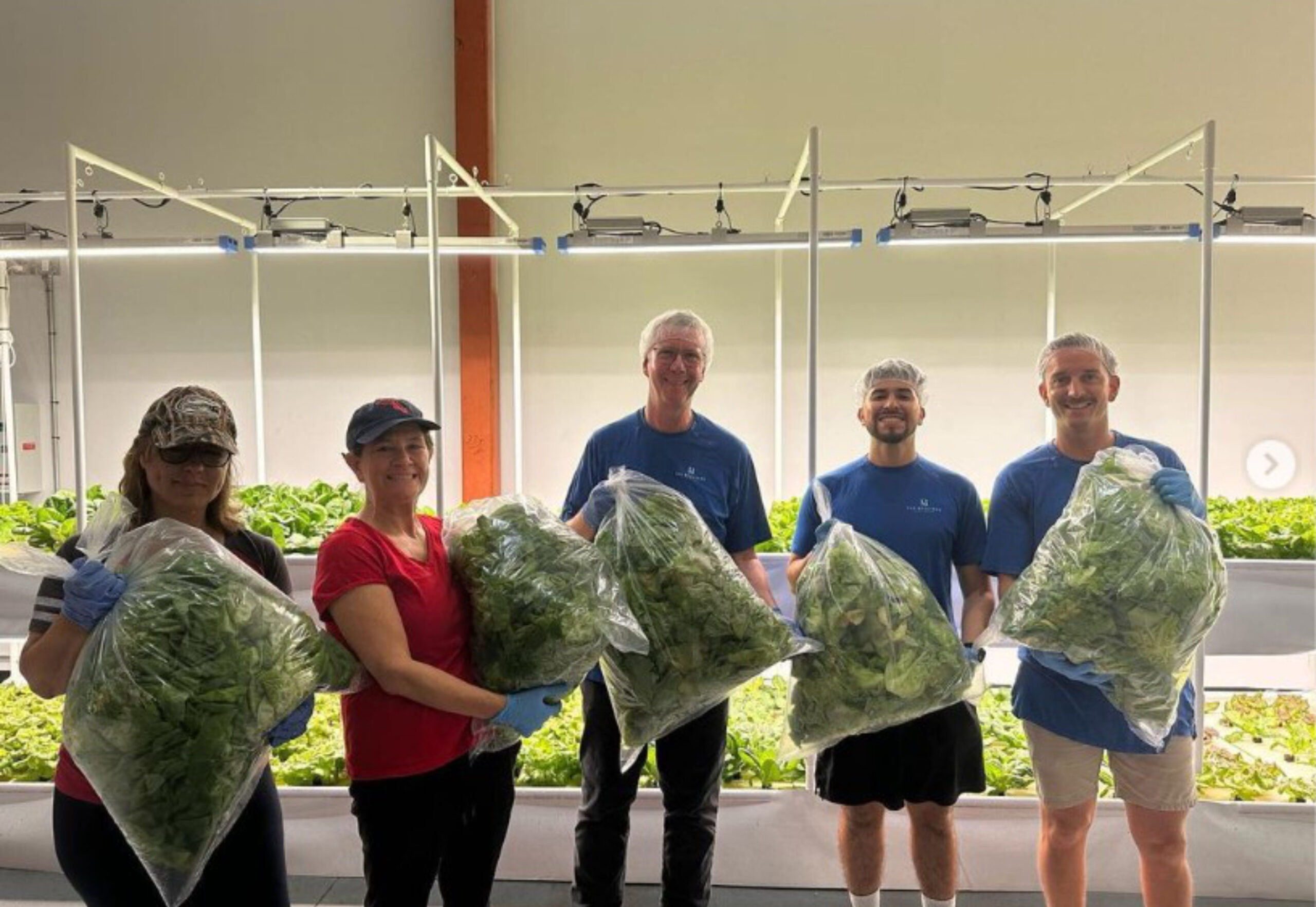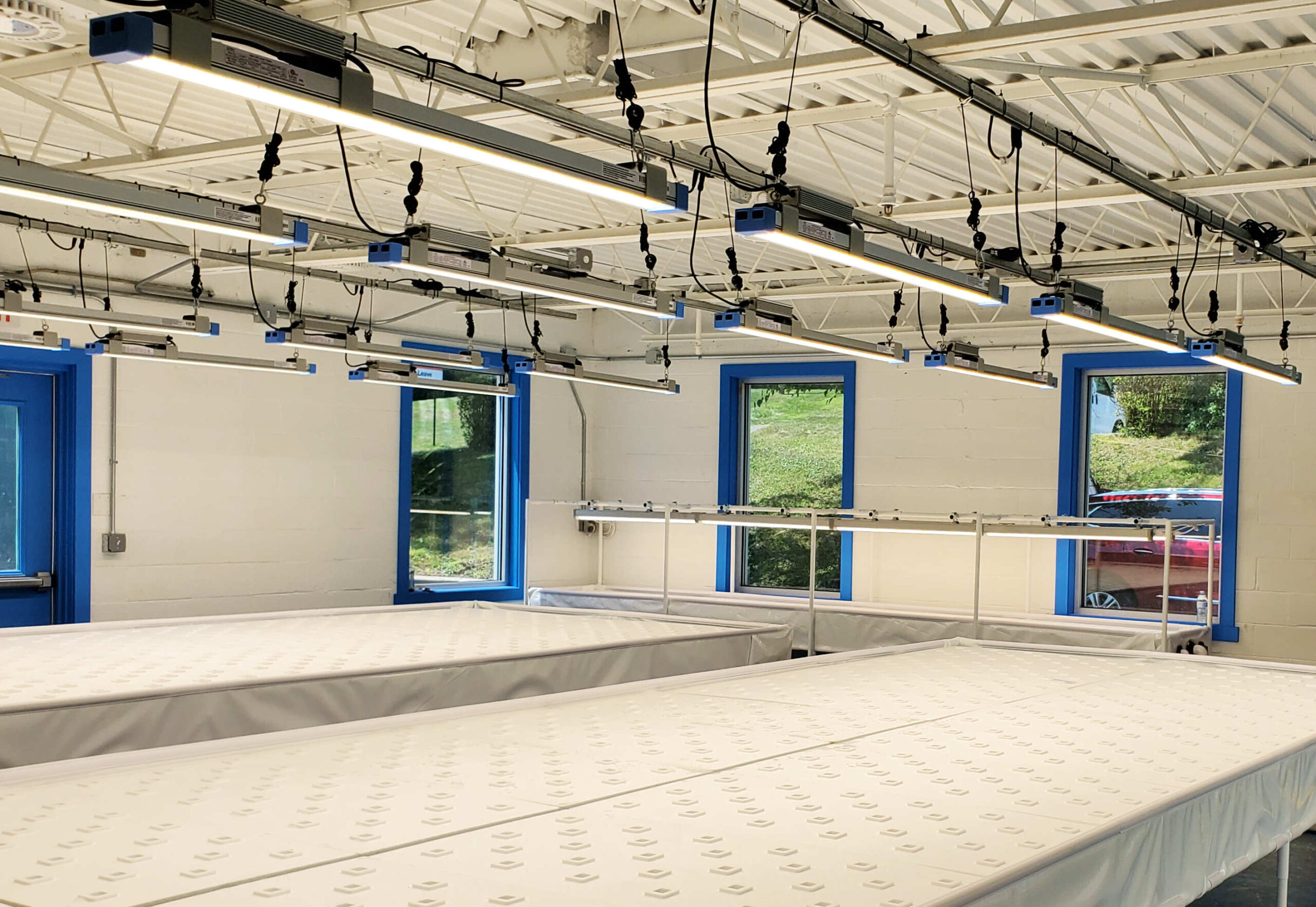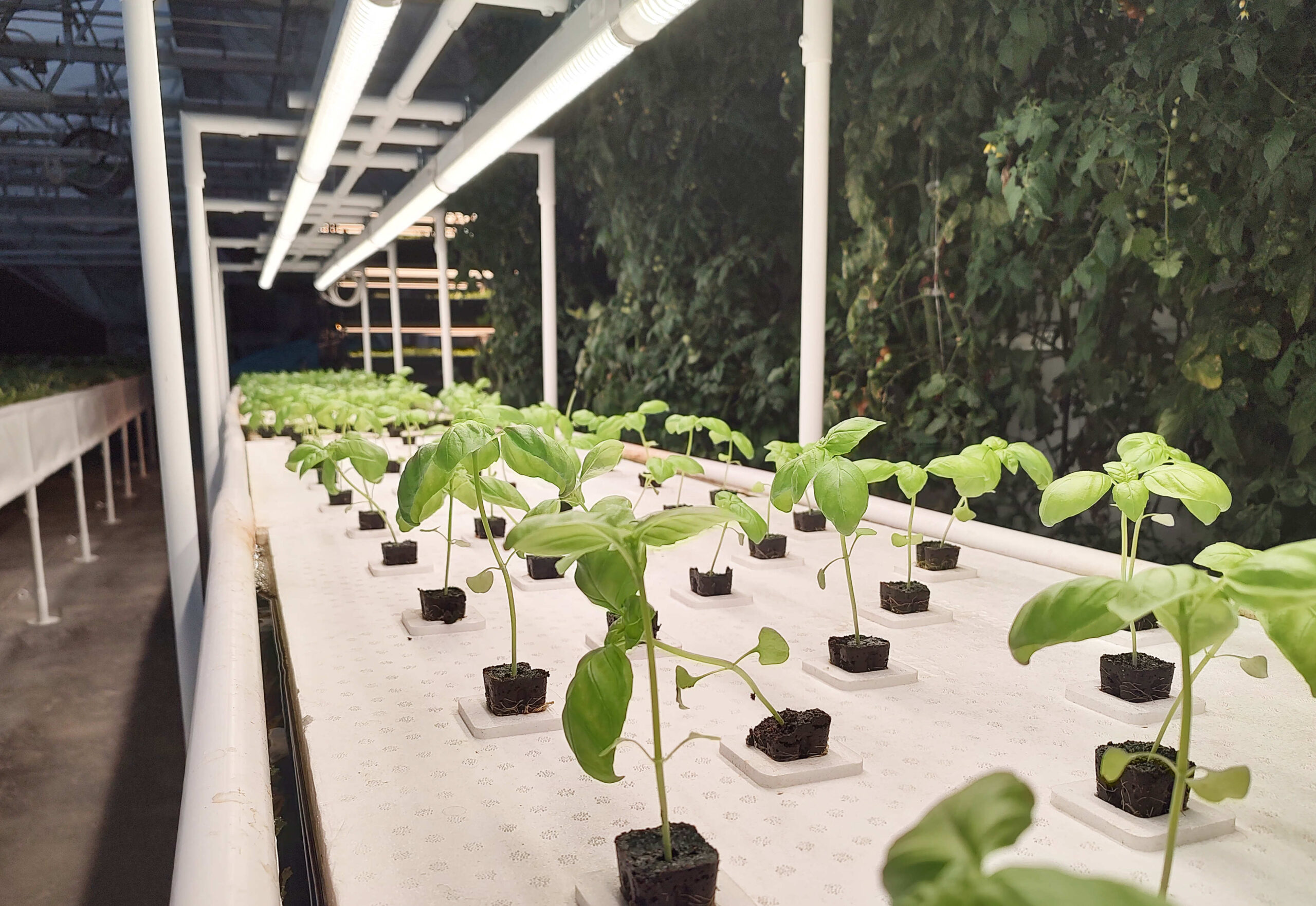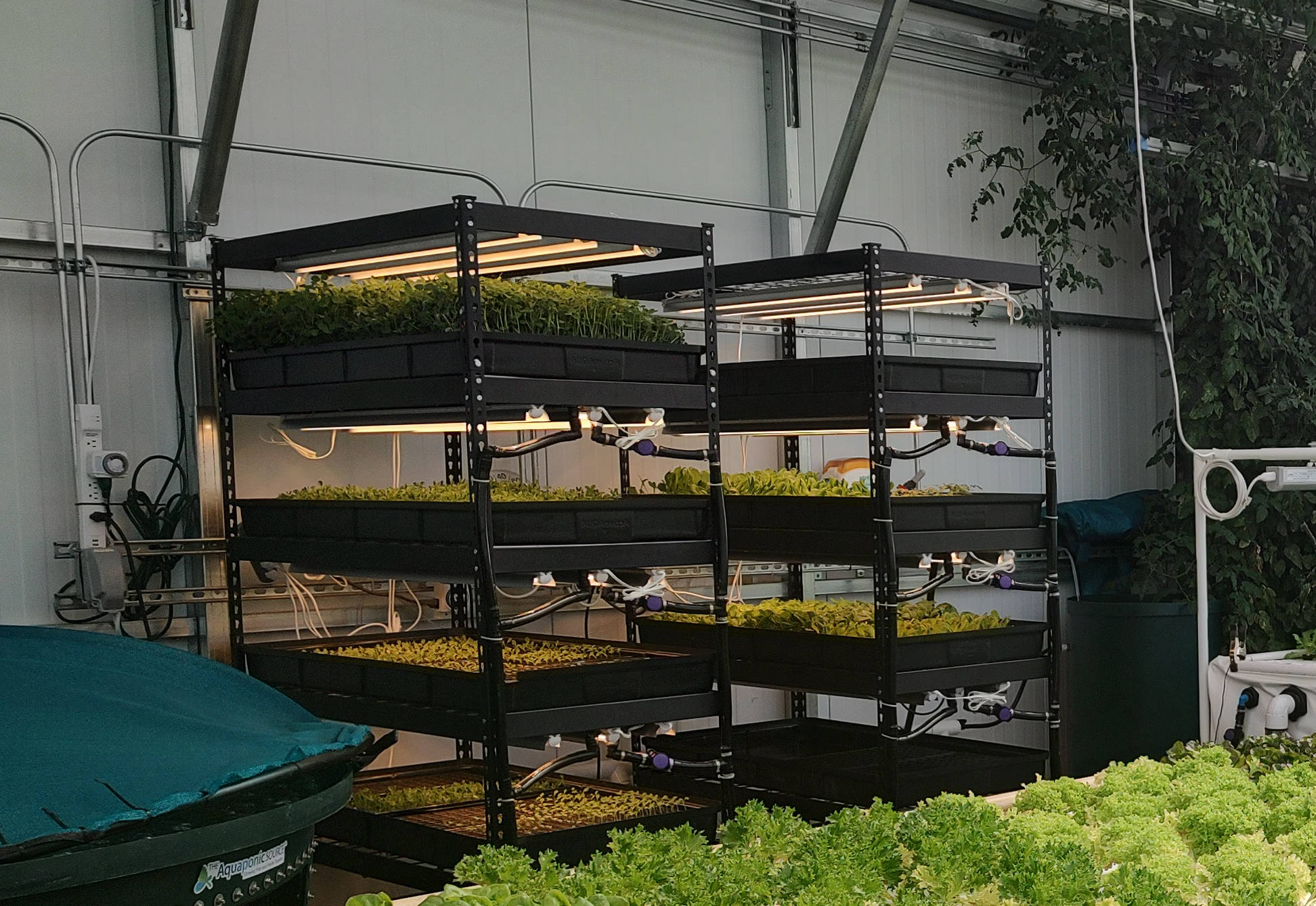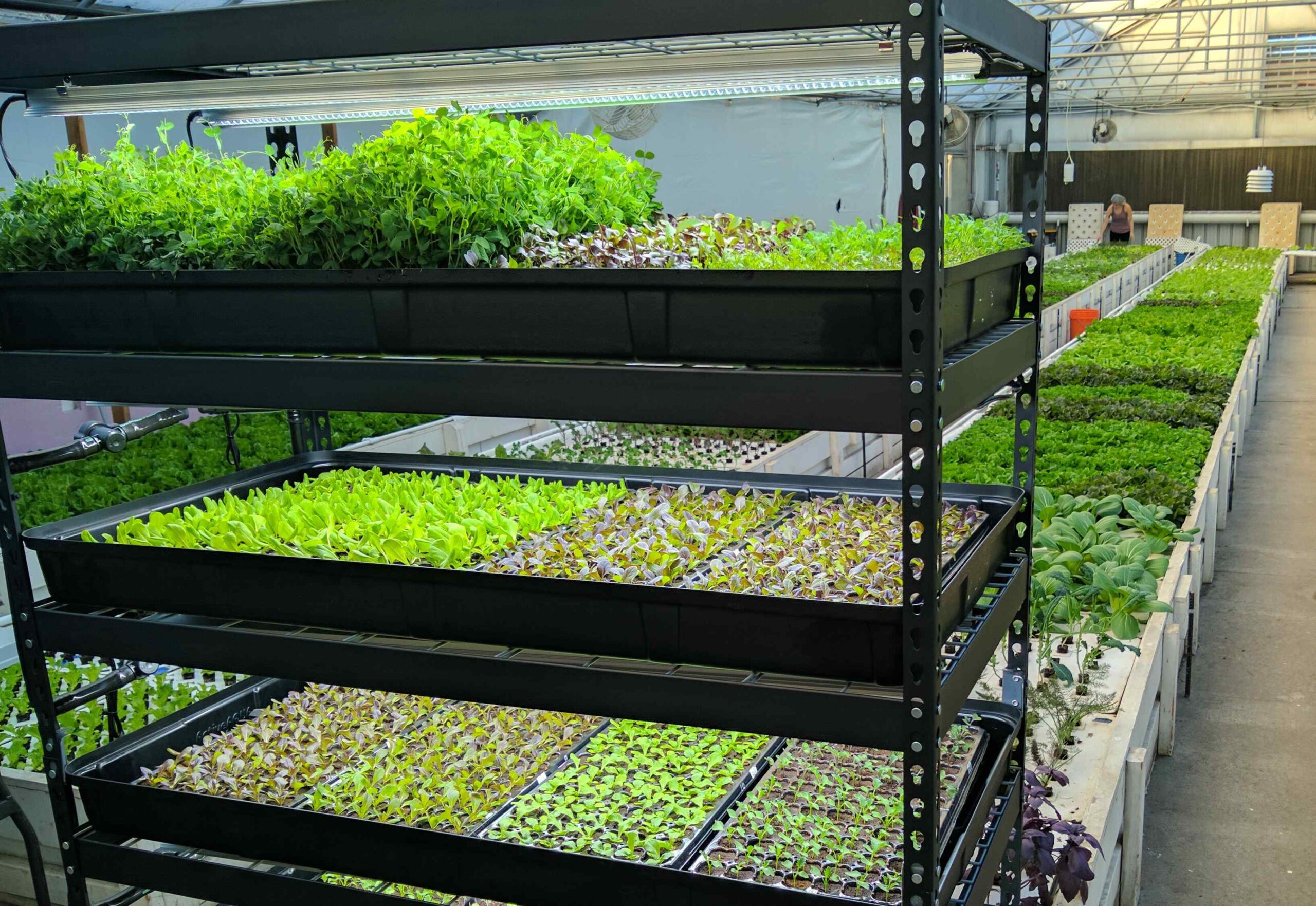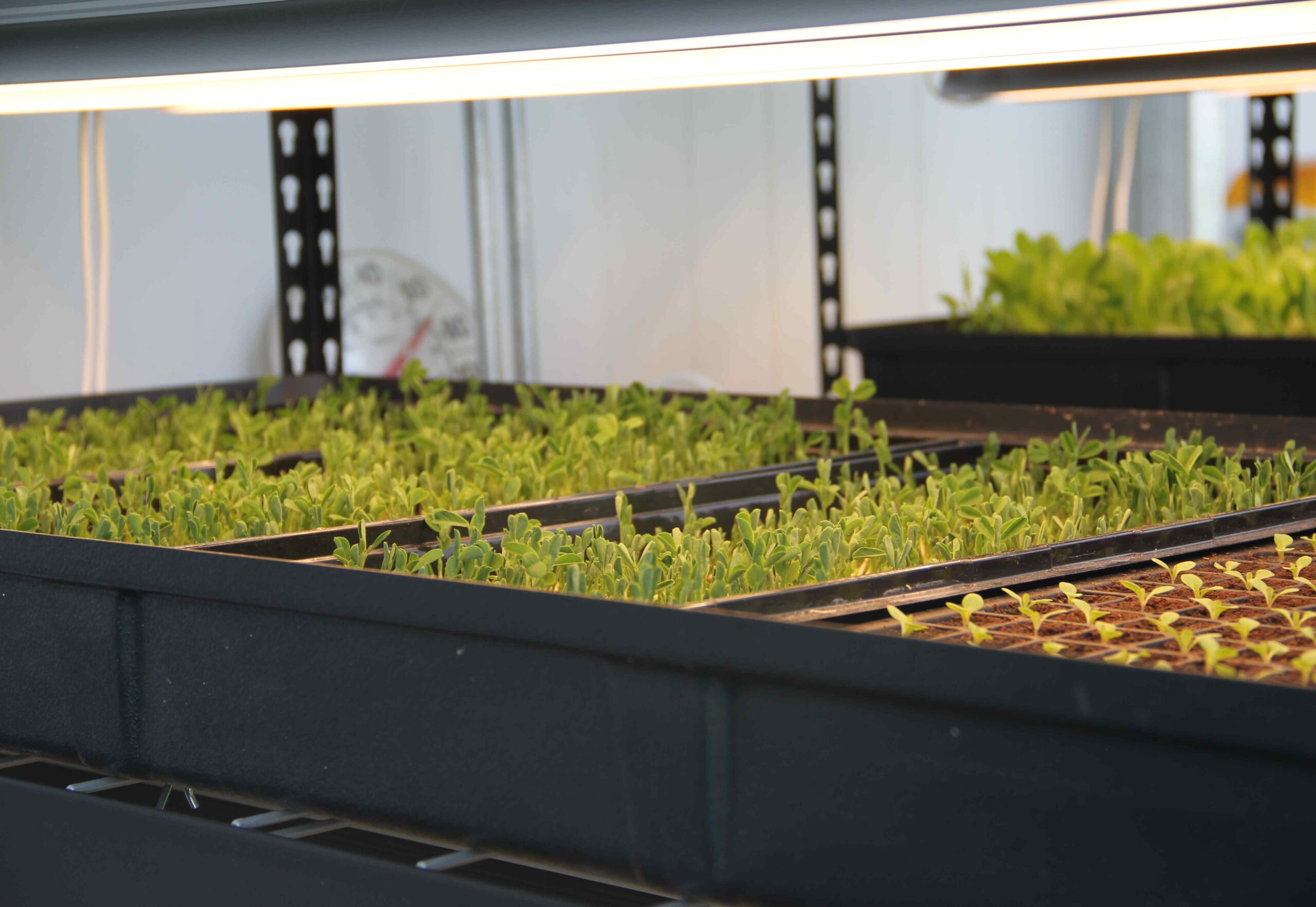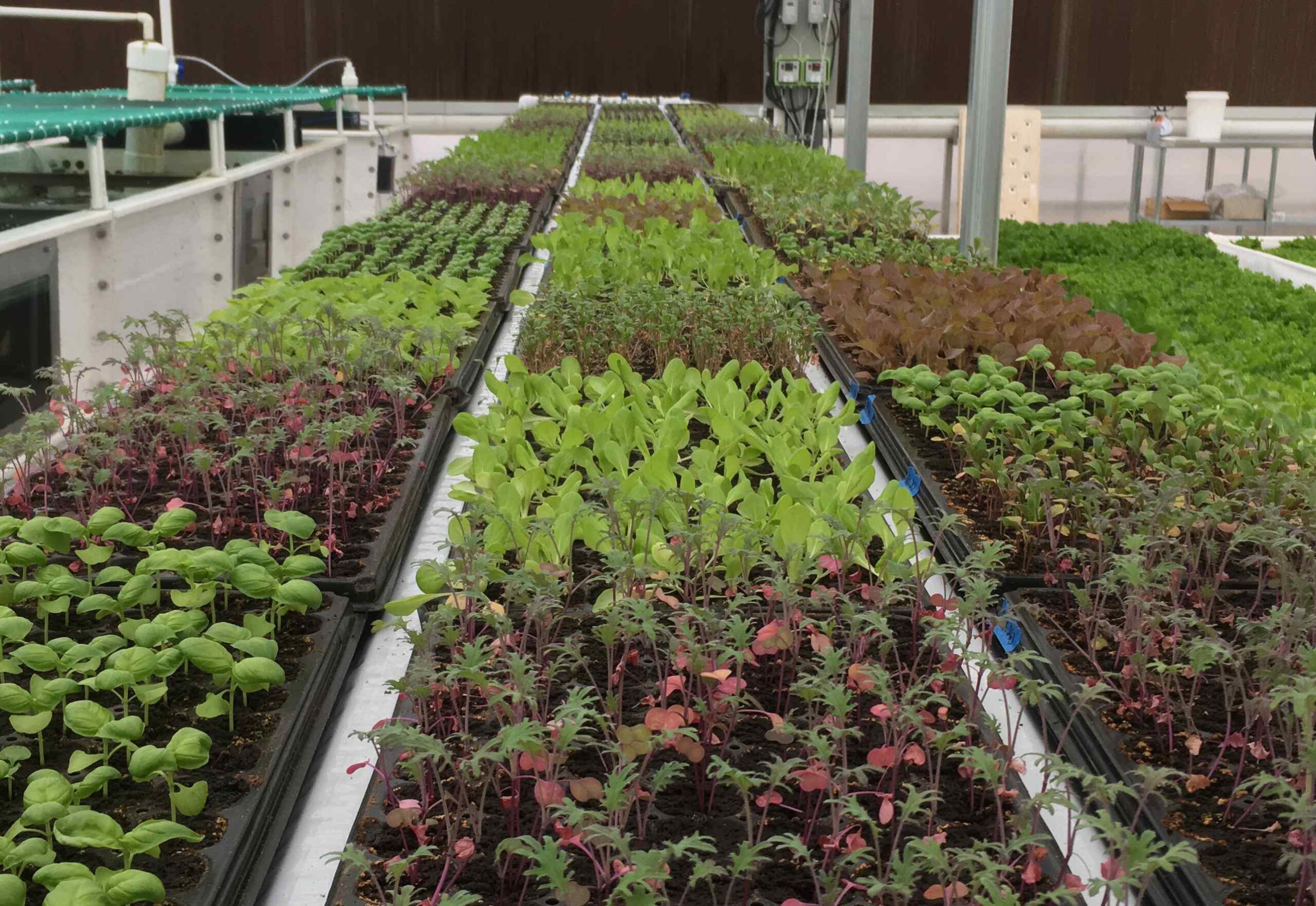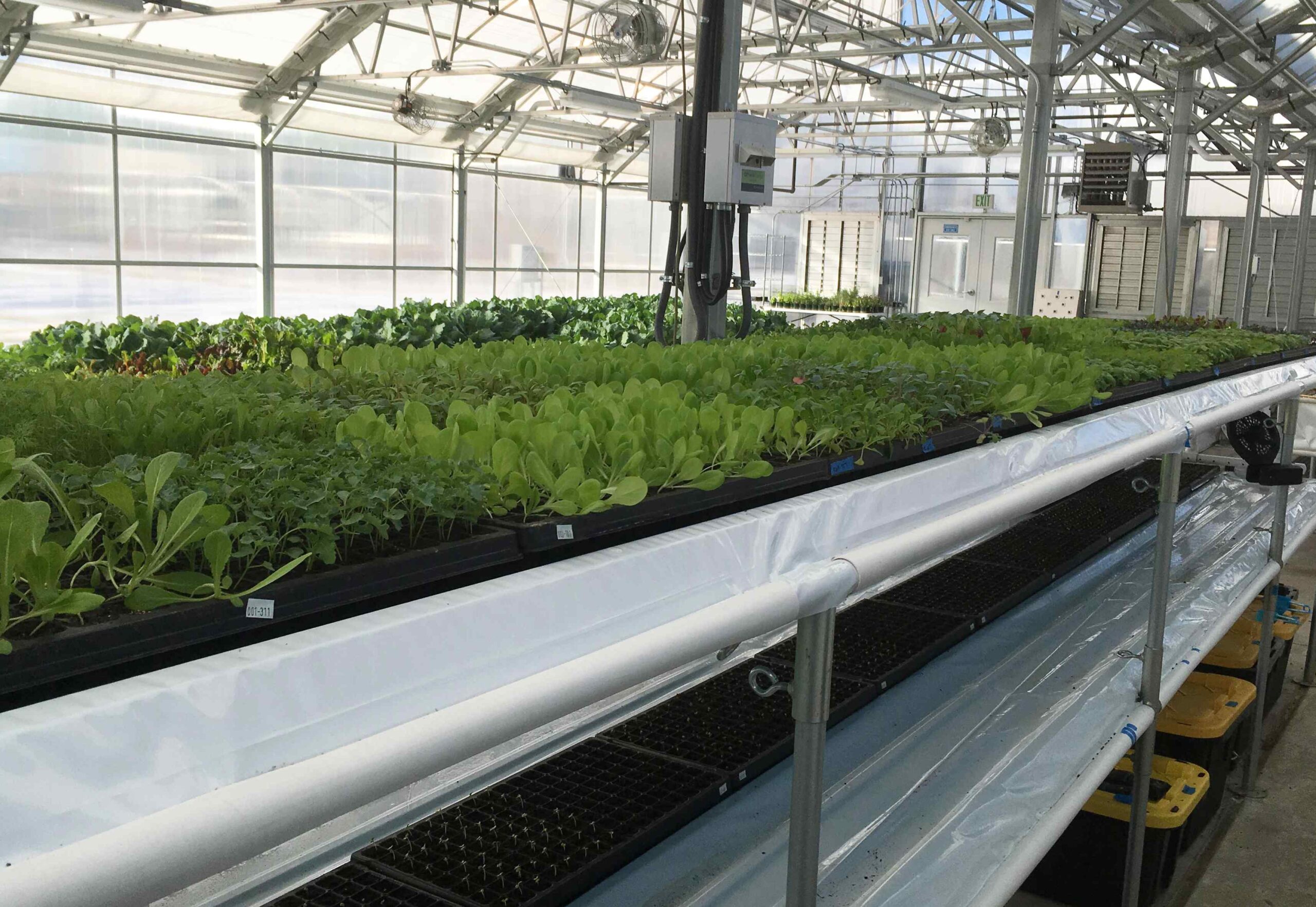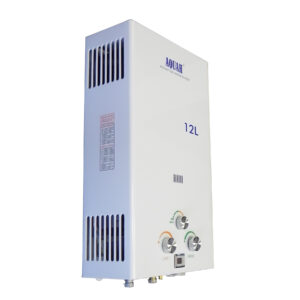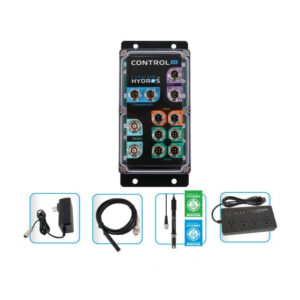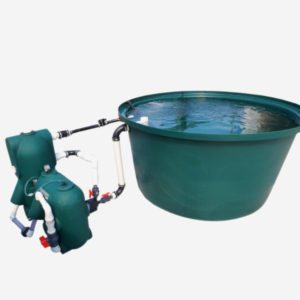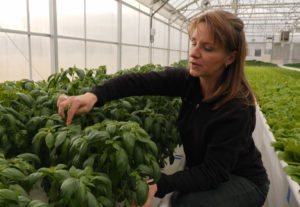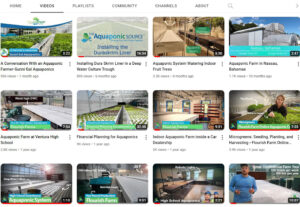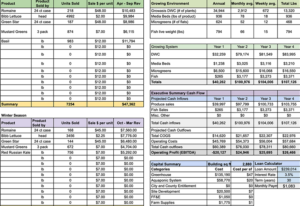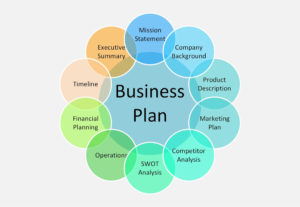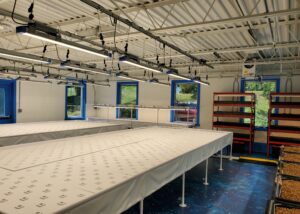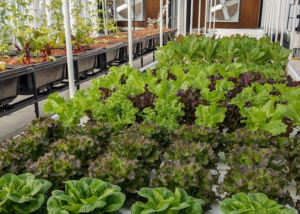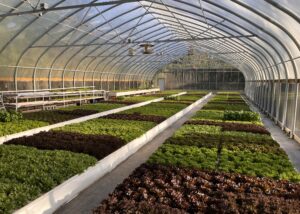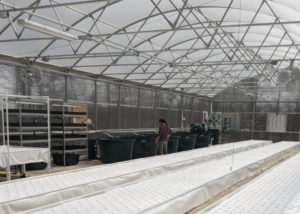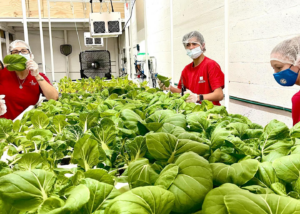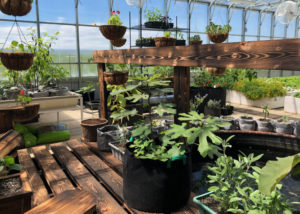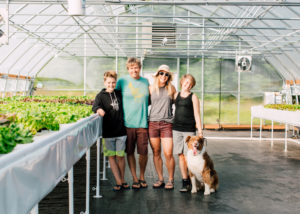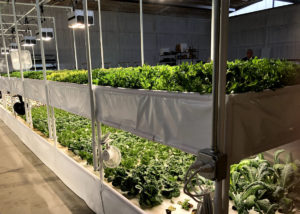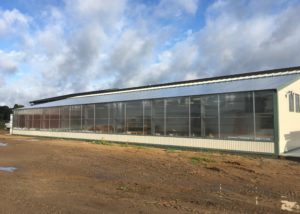Farms For the Future of Our Planet
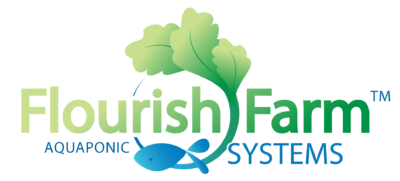
Flourish Aquaponic Farms™ are designed to raise fish and plants together in a practical, productive and ecologically balanced system. The high volume production of leafy greens, herbs, fruiting crops, and fish takes place in a recirculating system. Our farms use a fraction of the water compared to traditional agriculture and can grow food continuously year round.
Farms are designed based upon years of experience, sound scientific principles and industry best practices. Farm systems are scalable and can be configured to best fit your food production goals, space, and budget.
What Makes Our Farms Different
Meet the Farms!
Here are just a few examples of the many different farms sizes and layouts that are achievable.
Please contact us to tell us more about your project goals so we can design the right farm for you!
30′ x 98′ Farm with 12′ Head House
(4) 500 Gallon Fish Tanks in the Head House
(2) 8’x 84 Elevated Growasis DWC Troughs
(1) 4′ x 40′ Elevated Growasis DWC Trough
(8) 3×3 Media Beds
(3) Growasis Vertical Nursery Systems
Production Estimates
Leafy Greens ≅ 63,627 yr – 5,302 mth
Microgreen Flats (10×20) ≅ 728 yr – 60 mth
Tomatoes, Squash, Peppers and Cucumbers – TBD
Barramundi Gross Weight ≅ 1,150 lbs.
Ceres Passive Solar Greenhouse
30′ x 80′ Flourish Farm
(3) 500 Gallon Fish Tanks
(2) 8’x 68′ Elevated Growasis DWC Troughs
(1) 2′ x 20′ Elevated Growasis DWC Trough
(2) Growasis Vertical Nursery Systems
(16) AutoPot Self Watering Buckets
Production Estimates
Leafy Greens ≅ 51,394 yr – 4,277 mth
Microgreen Flats (10×20) ≅ 182 yr – 16 mth
Tomatoes ≅ 2,880 lbs.
Fish Gross Weight ≅ 1,000 lbs.
Ceres Passive Solar Greenhouse
Visit the Farm on our Youtube Channel
5,000 sq ft Flourish Farm w/ optional head house
(3) 1,200 Gallon Fish Tanks
(3) 8’x 96′ Elevated Growasis DWC Troughs
(1) 4′ x 36′ Elevated Growasis DWC Trough
(4) Growasis Vertical Nursery Systems
(8) Aquabundance Media Beds
Production Estimates
Leafy Greens ≅ 111,384 yr – 9,282 mth
Microgreen Flats (10×20) ≅ 780 yr – 65 mth
Tomatoes ≅ 1,440 lbs.
Fish Gross Weight ≅ 2,230 lbs.
ClearSpan Greenhouse Shown in Images
7,500 sq ft Farm with head house
The plant system occupies two 30′ x 100′ gutter connected bays with a 15′ x 100′ headhouse for the aquaculture system, office, processing and storage.
(6) 800 Gallon Fish Tanks
(5) 8’x 88′ Elevated or Ground Level Growasis DWC Troughs
(4) Growasis Vertical Nursery Systems
(100) AutoPot Self Watering Buckets (Optional)
Production Estimates
Leafy Greens ≅ 160,000 yr – 13,350 mth
Tomatoes ≅ 4,500 lbs. (avg. 45 lb yield per plant)
Fish Gross Weight ≅ 2,800 lbs.
Prospiant Greenhouse shown in image
10,000 sq ft Indoor Farm
This system is designed for a 100′ x 100′ indoor warehouse facility.
(6) 950 Gallon Fish Tanks
(5) 4’x 84′ Growasis Double Decker DWC Troughs
(1) 4′ x 76′ Growasis Elevated DWC System
(1) 3′ x 35′ Growasis 3-Tier Nursery/Microgreen Deck System
(16) Aquabundance Media Beds
(314) AutoPot Self Watering Buckets
Production Estimates
Leafy Greens ≅ 150,000 heads annually
Tomatoes ≅ 14,130 lbs. (avg. 45 lb yield per plant)
Microgreens ≅ 3,900 microgreen flats annually
Bell Peppers ≅ 720 lbs from media beds annually
Fish Gross Weight ≅ 3,200 lbs.
30′ x 60′ Flourish Farm
This system was built for a school so extra aisle space was provided for ADA access, large group tours and classes. Students run the entire greenhouse with an advisor. Other variations of a 30 x 60′ can include more DWC production.
(3) 300 Gallon Fish Tanks
(1) 8’x 40′ Elevated Growasis DWC Troughs
(1) 6′ x 40′ Elevated Growasis DWC Trough
(1) Growasis Vertical Nursery Systems
(7) Aquabundance Media Beds
(1) FFF 200 Quarantine and Purge System
Ceres Passive Solar Greenhouse
23′ x 40′ Flourish Farm
Grow food for your family, friends and sell the rest to restaurants or your local farmers market.
(2) 300 Gallon Fish Tanks
(1) 8’x 28′ Ground or Elevated Growasis DWC Trough
(1) 4′ x 24′ Ground or Elevated Growasis DWC Trough
(1) Growasis Vertical Nursery System
(5) Aquabundance Media Beds
(1) FFF 200 Quarantine and Purge System
Production Estimates
Leafy Greens ≅ 14,000 yr – 1,200 mth
Tomatoes ≅ 900 lbs. (avg. 45 lb yield per plant)
Fish Gross Weight ≅ 280 lbs.
Core Farm Features
Growasis Modular DWC Troughs
Ground Level – Waist High – Double Decker
The primary method for plant production in our farms is Deep Water Culture. DWC has been proven for decades in research and production farms as the most reliable and consistent way to grow a wide variety of crops. Roots take up water, oxygen and nutrients below the raft while the plants grow above, getting the greatest benefit of sunlight, proper spacing and airflow.
Growasis systems can be built at ground level, elevated to waist height or as double decker systems. All Growasis DWC troughs are made with powder coated tubular metal. There are no exposed sharp edges on our troughs! Installation is easy and requires no special tools. Systems come with Duraskrim 20mm liner, weighted air rings, plumbing kits, Alita ultra quiet air pumps and Beaver Plastics food grade raft boards.
Media Beds
Our farms can incorporate traditional media beds to provide the perfect soilless growing medium for crops such as tomatoes, peppers, squash or even dwarf fruit trees. Media beds also contribute to the overall bacterial surface area in the system.
Media beds come with a heavy duty powder coated metal frame (w/ optional light rack), grow beds, expanded clay grow media, independent flow control and all necessary plumbing to connect the supply and return to the plant sump.
Autopots
AutoPots can be a nice alternative to media beds. Autopots receive water via gravity from a dedicated reservoir. The pots automatically top off water using an internal float valve built into each pot. Pots sit right on the floor allowing for more vertical space for large vining crops. Multiple pots can be connected to a single feed line. Nutrients can be adjusted in the Autopot reservoir independently from the main aquaponic system allowing you to fine nutrients for fruiting crops without impacting your DWC troughs. Other crops can be grown such as potatoes, onions, herbs, carrots and most other root vegetables.
Fish Tanks and Filtration
Our fish tanks are perfect for growing Tilapia, Koi, Catish, Hybrid striped bass, and many other species. The number and volume of fish tanks required in your farm is determined by the size of the plant system. In most farms, the tanks are on the ground for easy access without the need for expensive stands or decks.
Flourish Farms use AST Polygeyser filters for mechanical and biological filtration in a single unit occupying only 8 sq ft! This allows more room for fish and plant production without wasting valuable space to large multi tank filtration systems. No media cleaning or replacement is necessary. The auto-pneumatic backwash limits the water loss to the removal of concentrated sludge. Sludge can then be added to the aerobic mineralization tank for further breakdown into usable nutrients for your plants.
Grow Lighting Systems
Depending on your location or if you are in an enclosed building, your farm may require grow lights to maintain optimal light levels and crop yields. Our design team uses real location-based data to determine how much light your plants will naturally receive, and tailors custom grow lighting solutions to provide the exact amount of light that your plants require.
We utilize highly efficient, high-output LED fixtures, controllers, and light monitoring systems. A lighting design layout, electrical plan and schedule are created for each farm.
Growasis Nursery and Microgreen Systems
Our most popular option is the Growasis vertical nursery system which allows for up to (16) 128 hole seedling trays (2,048 seedlings) in 8 total square feet! Nursery systems are fully automated with a dedicated nutrient reservoir, plumbing, aeration, and LED lighting on each of the four levels.
Seedlings grow in the nursery for 2 weeks before transplanting into the larger grow out troughs. Additional space on the nursery decks can be used for production of microgreens or other early stage plants.
A longer two deck modular nursery system is also available for larger farms with more space.
Optional Components
Ready to Get Started on Your Aquaponic Project?
Farm Resources
Farm FAQs
Each farm utilizes a single main pump in normal operating mode running continuously. When running in decoupled mode the farm utilizes two pumps simultaneously, one for the fish system and one for the plant system. We also use Alita air pumps for the 24/7 Aeration system required to provide dissolved oxygen to the water. We offer options to heat the water using propane, natural gas or electric as well. Electric heat can be expensive and can significantly increase the energy footprint of the farm. If you need to heat the water we generally recommend one of our propane or natural gas heating units. These units can be sized appropriately for each farm based upon the total water volume and expected temperature delta.
Each farm we design is different so we provide an electrical drawing for outlet locations and an electrical schedule detailing all of the operating components, expected run times and power consumption.
First of all we appreciate everyone, including our competitors, who is working to advance better ways of growing food and promoting aquaponics. We don’t disparage others in the industry and we encourage people to take as many classes and workshops as they can from reputable aquaponic companies.
However, we do advise people to do their research and make sure they are working with companies and consultants who have a proven and experienced track record. There are many important aspects of designing an ecologically balanced system to ensure consistent and successful long term operations. Companies should have a minimum of five years of experience operating farms as a business along with designing, building and supporting systems. Make sure they can demonstrate the successful completion of projects and provide customer references.
Make sure the company has the capability to manufacture and deliver a fully functioning system with all of the parts and equipment you need to build and operate the farm.
Our Flourish Farm systems are sold turnkey so everything you need for a fully functioning system is included except the fish and plant seeds. There are a few items such as foam insulation board or plywood for elevated DWC troughs that cannot be shipped and have to be picked up locally. Your final quote will indicate whether those items are included in your quote or need to be purchased by you.
Here’s a comprehensive list of everything included with our Flourish Farm Systems
- Fish Tanks (with optional window kits)
- AST Polygeyser Filtration System
- Growasis Modular Raft System(s) – Ground level, Elevated or Double Decker – All Growasis systems come with our easy to assemble metal framing system, insulation panels for underlayment and sidewalls, Duraskrim 20mm liner, aeration system and Food Grade Beaver Rafts Boards
- Low noise linear air pumps, air diffusers and air distribution tubing for fish and plant systems
- Submersible or External pumps for the main fish and plant system
- Growasis Vertical Nursery and Microgreen System with shelving rack, LED lights, flood tables, nutrient reservoir, pump, aerator, timer and all plumbing components
- Aerobic Mineralization Tank
- Active carbon filter system with automatic water top off
- Optional Autopots or AquaBundance Modular Media Bed system – Includes powder coated metal framing, grow beds, growing media, all plumbing components (light rack optional)
- Optional Artificial Lighting Systems
- Optional Monitoring and Alerting System
- Clean-out valves with a hose hookup should you need to purge a major plumbing line
- Industrial pipe covering ramp for plumbing that crosses the walkway or trench covers for below ground pipe trenches
- All PVC pipe, fittings and valves
- Farm cycling, pest management, water test kits and nutrient adjustment solutions.
- Plug trays for seedlings
- Fish net, fish feed
It Depends… (You probably saw that one coming). There’s a lot to be said on this topic but here is one way of addressing the “it depends” answer. The following tables present a range of hypothetical production numbers, price points and the resulting potential gross revenue. The second table lists several of the many factors that will influence those numbers. In order to achieve profitability in your farm you will have to manage these factors (and others) to ensure the best production and financial performance for your farm. In our Flourish Farm Business Course we spend a lot of time focusing and training farmers on how to manage these factors.
Cells in dark green illustrate the wide range of potential revenues a farm can theoretically have based upon price vs. annual harvests. Average Culture Time represents the time from which the seedling was transplanted into the main DWC troughs to when it was harvested. One farm may be turning their product at a much faster rate than another farm and selling at a much higher price point. In other words, two identical farms can perform much differently depending on the variety of factors listed below. In general, your farm will likely perform somewhere in the middle of the range represented by the green cells.
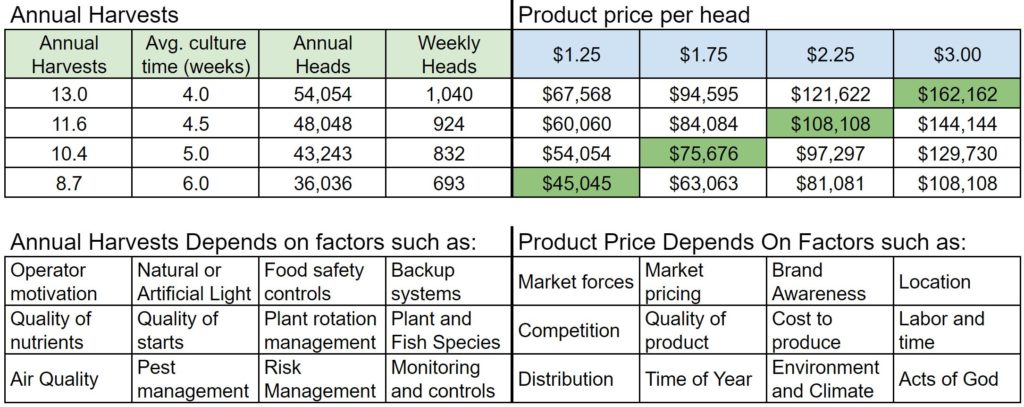
Water from the fish tanks feeds by gravity through the filtration system. Fish solid waste is captured in the filter and bacteria on the surface of the biofilter media convert toxic ammonia to nitrates. An aerobic digester tank allows solids that are removed from the filter to be further “mineralized” to maximize nutrient availability. These additional nutrients can be reintroduced to the system or used for other crops. Following the filter water flows into the dual sump system. The dual sumps can be connected or disconnected (discussed further in decoupling). Water is pumped back to the fish tank and also simultaneously to the plant systems. Water pumped to the plant systems returns back to the sumps. Low noise linear air pumps provide aeration to the fish and plant systems.
The recirculating nature of the farm allows for reuse of water and absorption of nutrients which are continuously being produced by the fish. No water needs to be discharged from the farm. Water will need to be topped off periodically due to natural losses from evapotranspiration which are detailed in the energy and water section of this document.
Featured Projects
We’ve been busy designing and installing aquaponic systems big and small, across the country and abroad.
We are proud to highlight these successful farm and community projects.

